Strategic information systems - Assignment
VerifiedAdded on 2021/05/31
|18
|4952
|20
AI Summary
Contribute Materials
Your contribution can guide someone’s learning journey. Share your
documents today.
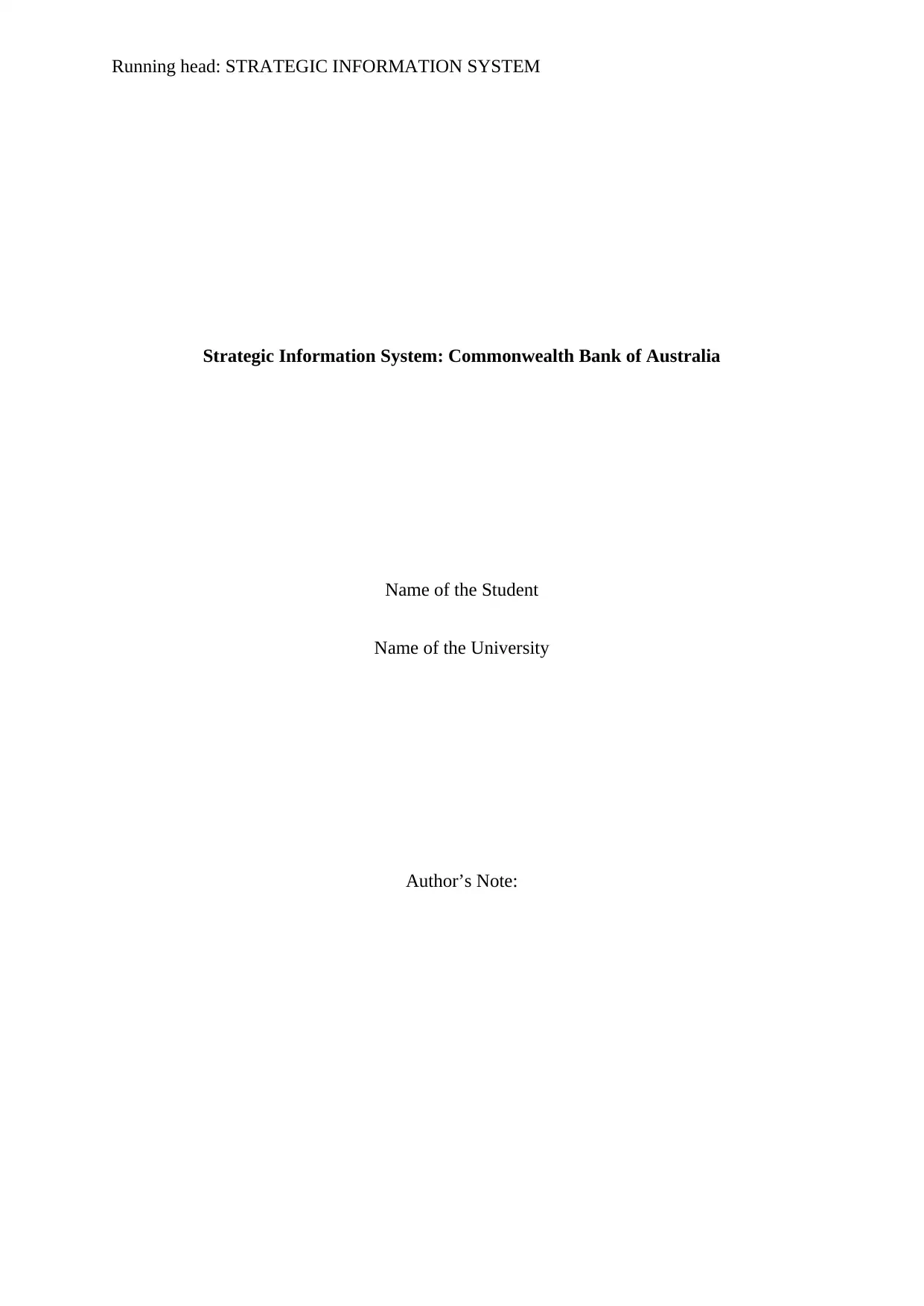
Running head: STRATEGIC INFORMATION SYSTEM
Strategic Information System: Commonwealth Bank of Australia
Name of the Student
Name of the University
Author’s Note:
Strategic Information System: Commonwealth Bank of Australia
Name of the Student
Name of the University
Author’s Note:
Secure Best Marks with AI Grader
Need help grading? Try our AI Grader for instant feedback on your assignments.
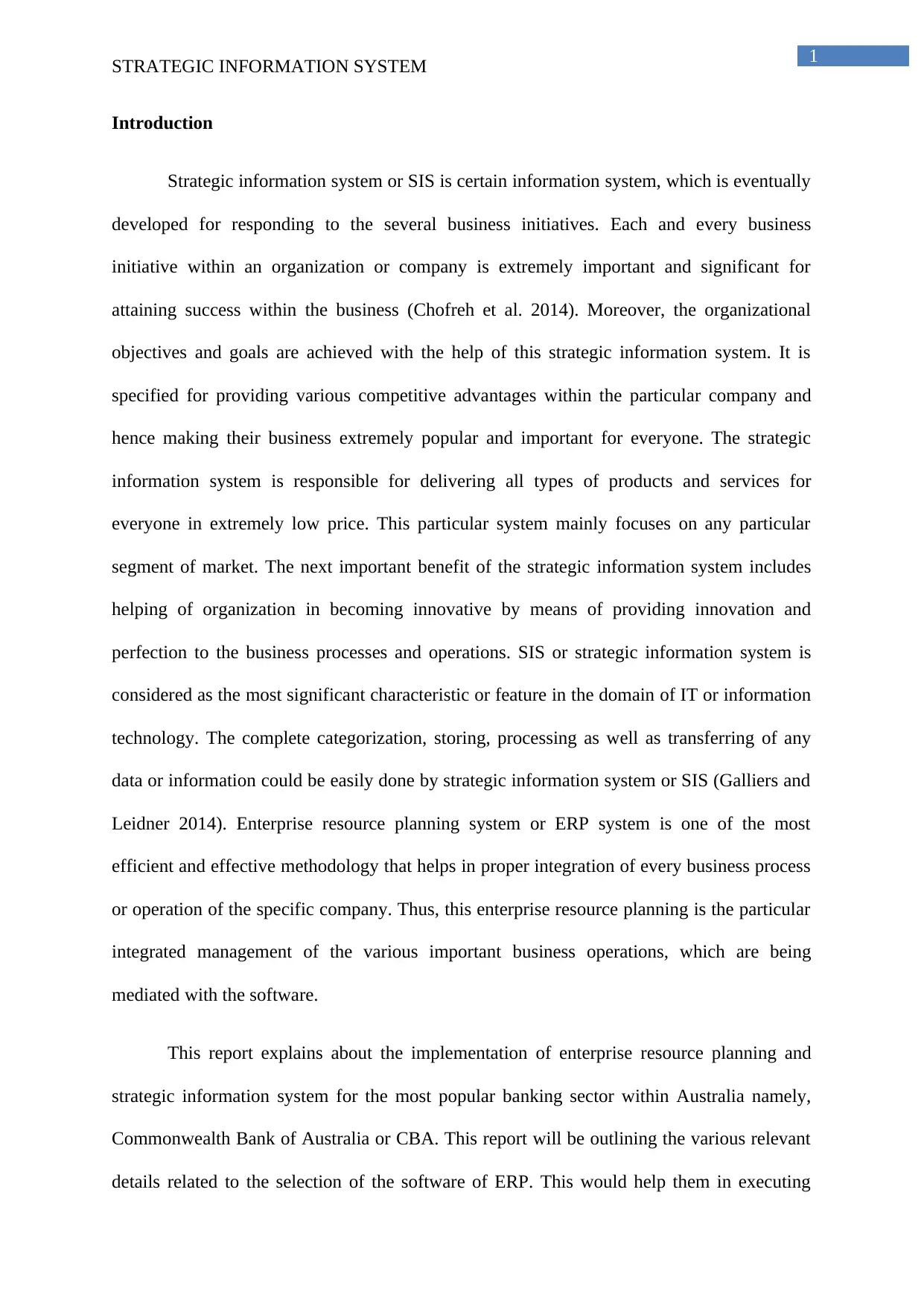
1
STRATEGIC INFORMATION SYSTEM
Introduction
Strategic information system or SIS is certain information system, which is eventually
developed for responding to the several business initiatives. Each and every business
initiative within an organization or company is extremely important and significant for
attaining success within the business (Chofreh et al. 2014). Moreover, the organizational
objectives and goals are achieved with the help of this strategic information system. It is
specified for providing various competitive advantages within the particular company and
hence making their business extremely popular and important for everyone. The strategic
information system is responsible for delivering all types of products and services for
everyone in extremely low price. This particular system mainly focuses on any particular
segment of market. The next important benefit of the strategic information system includes
helping of organization in becoming innovative by means of providing innovation and
perfection to the business processes and operations. SIS or strategic information system is
considered as the most significant characteristic or feature in the domain of IT or information
technology. The complete categorization, storing, processing as well as transferring of any
data or information could be easily done by strategic information system or SIS (Galliers and
Leidner 2014). Enterprise resource planning system or ERP system is one of the most
efficient and effective methodology that helps in proper integration of every business process
or operation of the specific company. Thus, this enterprise resource planning is the particular
integrated management of the various important business operations, which are being
mediated with the software.
This report explains about the implementation of enterprise resource planning and
strategic information system for the most popular banking sector within Australia namely,
Commonwealth Bank of Australia or CBA. This report will be outlining the various relevant
details related to the selection of the software of ERP. This would help them in executing
STRATEGIC INFORMATION SYSTEM
Introduction
Strategic information system or SIS is certain information system, which is eventually
developed for responding to the several business initiatives. Each and every business
initiative within an organization or company is extremely important and significant for
attaining success within the business (Chofreh et al. 2014). Moreover, the organizational
objectives and goals are achieved with the help of this strategic information system. It is
specified for providing various competitive advantages within the particular company and
hence making their business extremely popular and important for everyone. The strategic
information system is responsible for delivering all types of products and services for
everyone in extremely low price. This particular system mainly focuses on any particular
segment of market. The next important benefit of the strategic information system includes
helping of organization in becoming innovative by means of providing innovation and
perfection to the business processes and operations. SIS or strategic information system is
considered as the most significant characteristic or feature in the domain of IT or information
technology. The complete categorization, storing, processing as well as transferring of any
data or information could be easily done by strategic information system or SIS (Galliers and
Leidner 2014). Enterprise resource planning system or ERP system is one of the most
efficient and effective methodology that helps in proper integration of every business process
or operation of the specific company. Thus, this enterprise resource planning is the particular
integrated management of the various important business operations, which are being
mediated with the software.
This report explains about the implementation of enterprise resource planning and
strategic information system for the most popular banking sector within Australia namely,
Commonwealth Bank of Australia or CBA. This report will be outlining the various relevant
details related to the selection of the software of ERP. This would help them in executing
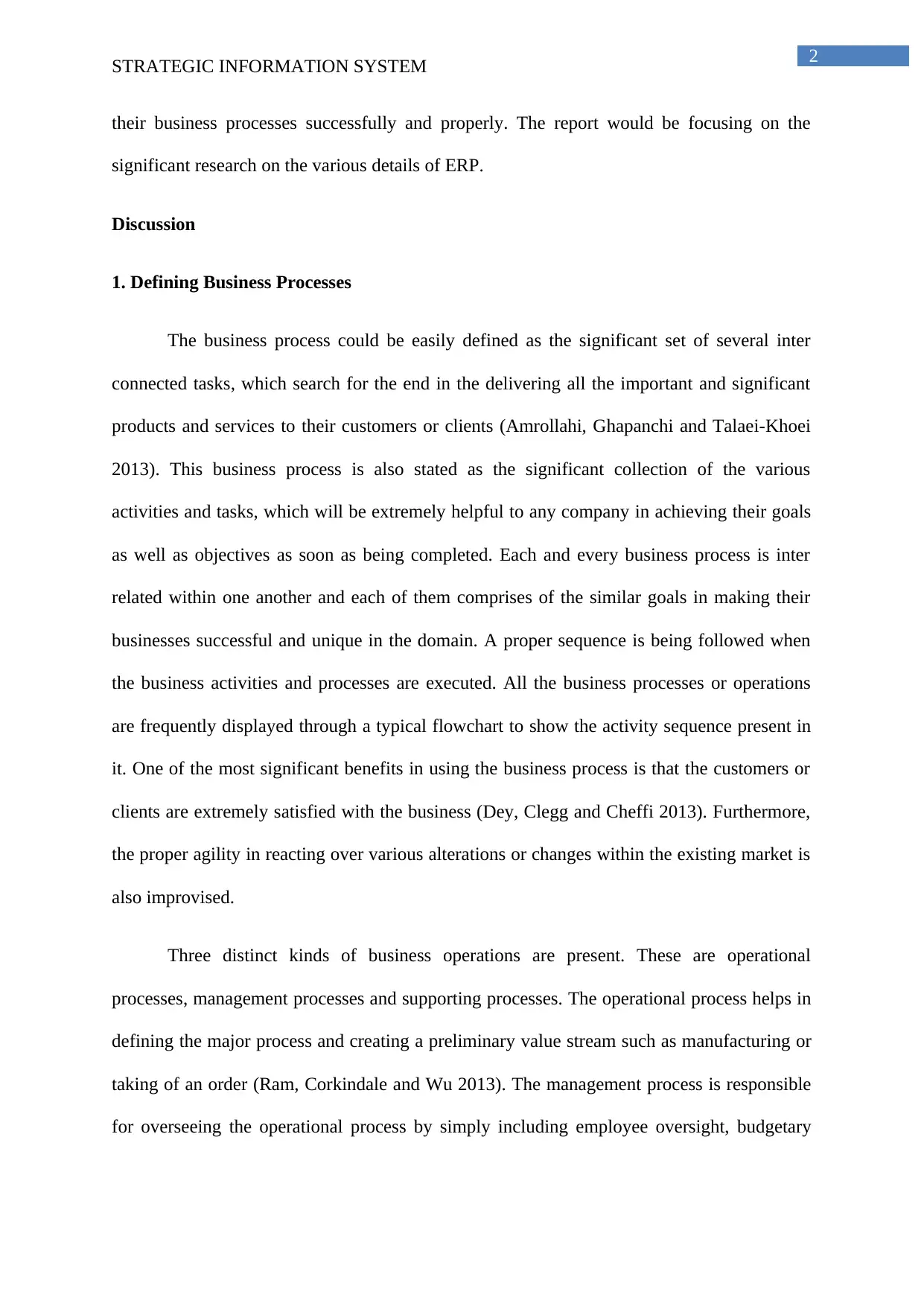
2
STRATEGIC INFORMATION SYSTEM
their business processes successfully and properly. The report would be focusing on the
significant research on the various details of ERP.
Discussion
1. Defining Business Processes
The business process could be easily defined as the significant set of several inter
connected tasks, which search for the end in the delivering all the important and significant
products and services to their customers or clients (Amrollahi, Ghapanchi and Talaei-Khoei
2013). This business process is also stated as the significant collection of the various
activities and tasks, which will be extremely helpful to any company in achieving their goals
as well as objectives as soon as being completed. Each and every business process is inter
related within one another and each of them comprises of the similar goals in making their
businesses successful and unique in the domain. A proper sequence is being followed when
the business activities and processes are executed. All the business processes or operations
are frequently displayed through a typical flowchart to show the activity sequence present in
it. One of the most significant benefits in using the business process is that the customers or
clients are extremely satisfied with the business (Dey, Clegg and Cheffi 2013). Furthermore,
the proper agility in reacting over various alterations or changes within the existing market is
also improvised.
Three distinct kinds of business operations are present. These are operational
processes, management processes and supporting processes. The operational process helps in
defining the major process and creating a preliminary value stream such as manufacturing or
taking of an order (Ram, Corkindale and Wu 2013). The management process is responsible
for overseeing the operational process by simply including employee oversight, budgetary
STRATEGIC INFORMATION SYSTEM
their business processes successfully and properly. The report would be focusing on the
significant research on the various details of ERP.
Discussion
1. Defining Business Processes
The business process could be easily defined as the significant set of several inter
connected tasks, which search for the end in the delivering all the important and significant
products and services to their customers or clients (Amrollahi, Ghapanchi and Talaei-Khoei
2013). This business process is also stated as the significant collection of the various
activities and tasks, which will be extremely helpful to any company in achieving their goals
as well as objectives as soon as being completed. Each and every business process is inter
related within one another and each of them comprises of the similar goals in making their
businesses successful and unique in the domain. A proper sequence is being followed when
the business activities and processes are executed. All the business processes or operations
are frequently displayed through a typical flowchart to show the activity sequence present in
it. One of the most significant benefits in using the business process is that the customers or
clients are extremely satisfied with the business (Dey, Clegg and Cheffi 2013). Furthermore,
the proper agility in reacting over various alterations or changes within the existing market is
also improvised.
Three distinct kinds of business operations are present. These are operational
processes, management processes and supporting processes. The operational process helps in
defining the major process and creating a preliminary value stream such as manufacturing or
taking of an order (Ram, Corkindale and Wu 2013). The management process is responsible
for overseeing the operational process by simply including employee oversight, budgetary
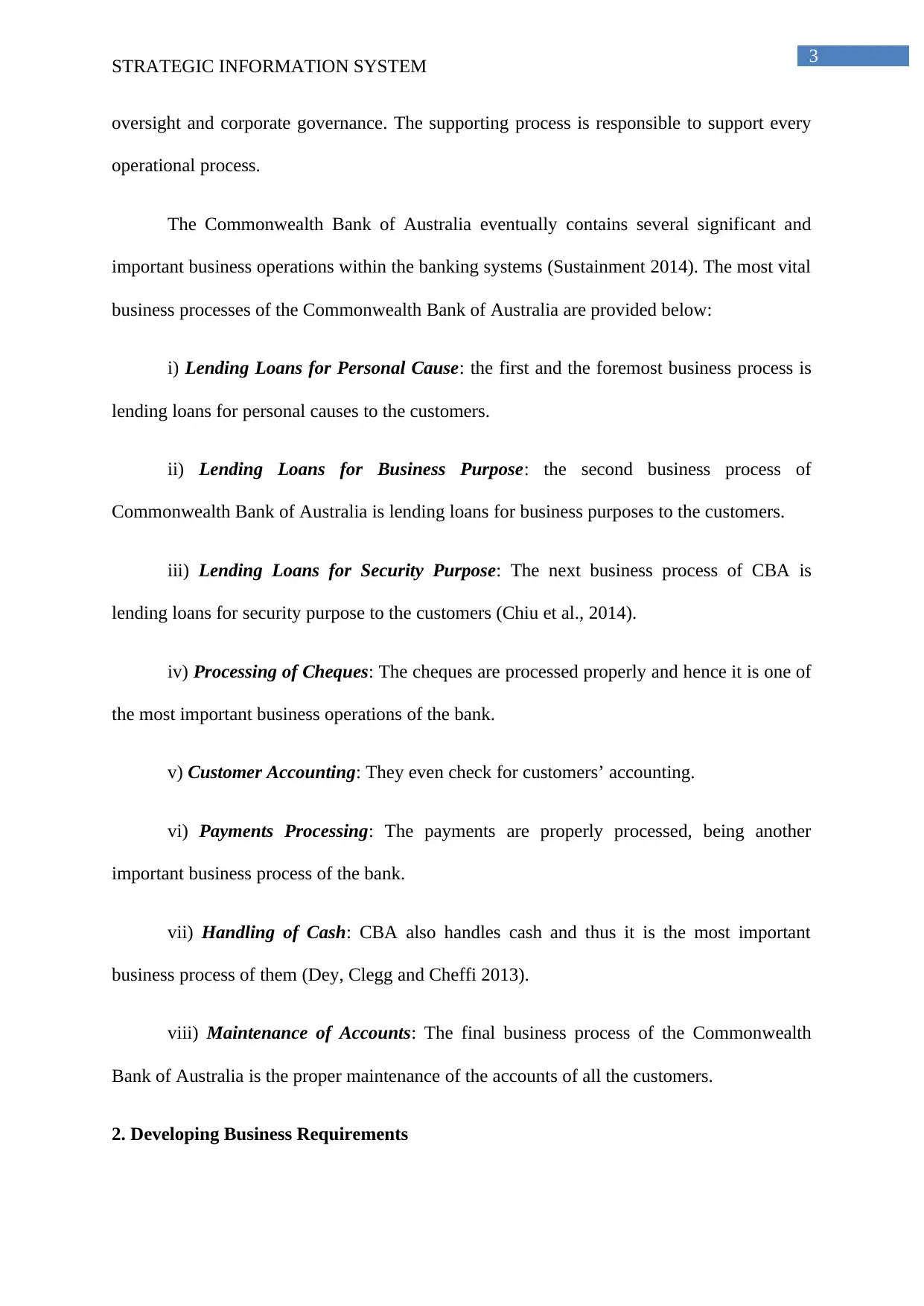
3
STRATEGIC INFORMATION SYSTEM
oversight and corporate governance. The supporting process is responsible to support every
operational process.
The Commonwealth Bank of Australia eventually contains several significant and
important business operations within the banking systems (Sustainment 2014). The most vital
business processes of the Commonwealth Bank of Australia are provided below:
i) Lending Loans for Personal Cause: the first and the foremost business process is
lending loans for personal causes to the customers.
ii) Lending Loans for Business Purpose: the second business process of
Commonwealth Bank of Australia is lending loans for business purposes to the customers.
iii) Lending Loans for Security Purpose: The next business process of CBA is
lending loans for security purpose to the customers (Chiu et al., 2014).
iv) Processing of Cheques: The cheques are processed properly and hence it is one of
the most important business operations of the bank.
v) Customer Accounting: They even check for customers’ accounting.
vi) Payments Processing: The payments are properly processed, being another
important business process of the bank.
vii) Handling of Cash: CBA also handles cash and thus it is the most important
business process of them (Dey, Clegg and Cheffi 2013).
viii) Maintenance of Accounts: The final business process of the Commonwealth
Bank of Australia is the proper maintenance of the accounts of all the customers.
2. Developing Business Requirements
STRATEGIC INFORMATION SYSTEM
oversight and corporate governance. The supporting process is responsible to support every
operational process.
The Commonwealth Bank of Australia eventually contains several significant and
important business operations within the banking systems (Sustainment 2014). The most vital
business processes of the Commonwealth Bank of Australia are provided below:
i) Lending Loans for Personal Cause: the first and the foremost business process is
lending loans for personal causes to the customers.
ii) Lending Loans for Business Purpose: the second business process of
Commonwealth Bank of Australia is lending loans for business purposes to the customers.
iii) Lending Loans for Security Purpose: The next business process of CBA is
lending loans for security purpose to the customers (Chiu et al., 2014).
iv) Processing of Cheques: The cheques are processed properly and hence it is one of
the most important business operations of the bank.
v) Customer Accounting: They even check for customers’ accounting.
vi) Payments Processing: The payments are properly processed, being another
important business process of the bank.
vii) Handling of Cash: CBA also handles cash and thus it is the most important
business process of them (Dey, Clegg and Cheffi 2013).
viii) Maintenance of Accounts: The final business process of the Commonwealth
Bank of Australia is the proper maintenance of the accounts of all the customers.
2. Developing Business Requirements
Secure Best Marks with AI Grader
Need help grading? Try our AI Grader for instant feedback on your assignments.
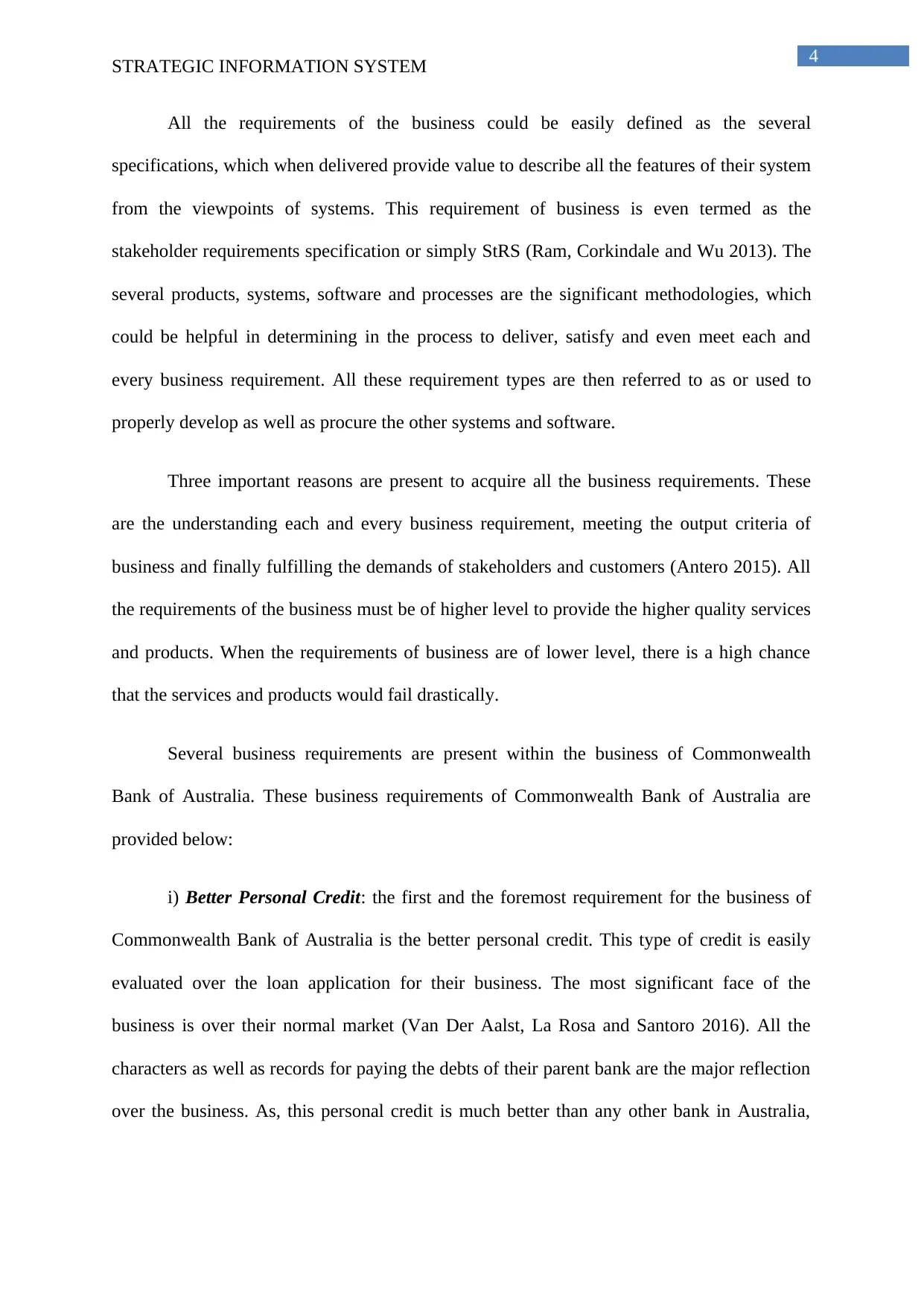
4
STRATEGIC INFORMATION SYSTEM
All the requirements of the business could be easily defined as the several
specifications, which when delivered provide value to describe all the features of their system
from the viewpoints of systems. This requirement of business is even termed as the
stakeholder requirements specification or simply StRS (Ram, Corkindale and Wu 2013). The
several products, systems, software and processes are the significant methodologies, which
could be helpful in determining in the process to deliver, satisfy and even meet each and
every business requirement. All these requirement types are then referred to as or used to
properly develop as well as procure the other systems and software.
Three important reasons are present to acquire all the business requirements. These
are the understanding each and every business requirement, meeting the output criteria of
business and finally fulfilling the demands of stakeholders and customers (Antero 2015). All
the requirements of the business must be of higher level to provide the higher quality services
and products. When the requirements of business are of lower level, there is a high chance
that the services and products would fail drastically.
Several business requirements are present within the business of Commonwealth
Bank of Australia. These business requirements of Commonwealth Bank of Australia are
provided below:
i) Better Personal Credit: the first and the foremost requirement for the business of
Commonwealth Bank of Australia is the better personal credit. This type of credit is easily
evaluated over the loan application for their business. The most significant face of the
business is over their normal market (Van Der Aalst, La Rosa and Santoro 2016). All the
characters as well as records for paying the debts of their parent bank are the major reflection
over the business. As, this personal credit is much better than any other bank in Australia,
STRATEGIC INFORMATION SYSTEM
All the requirements of the business could be easily defined as the several
specifications, which when delivered provide value to describe all the features of their system
from the viewpoints of systems. This requirement of business is even termed as the
stakeholder requirements specification or simply StRS (Ram, Corkindale and Wu 2013). The
several products, systems, software and processes are the significant methodologies, which
could be helpful in determining in the process to deliver, satisfy and even meet each and
every business requirement. All these requirement types are then referred to as or used to
properly develop as well as procure the other systems and software.
Three important reasons are present to acquire all the business requirements. These
are the understanding each and every business requirement, meeting the output criteria of
business and finally fulfilling the demands of stakeholders and customers (Antero 2015). All
the requirements of the business must be of higher level to provide the higher quality services
and products. When the requirements of business are of lower level, there is a high chance
that the services and products would fail drastically.
Several business requirements are present within the business of Commonwealth
Bank of Australia. These business requirements of Commonwealth Bank of Australia are
provided below:
i) Better Personal Credit: the first and the foremost requirement for the business of
Commonwealth Bank of Australia is the better personal credit. This type of credit is easily
evaluated over the loan application for their business. The most significant face of the
business is over their normal market (Van Der Aalst, La Rosa and Santoro 2016). All the
characters as well as records for paying the debts of their parent bank are the major reflection
over the business. As, this personal credit is much better than any other bank in Australia,
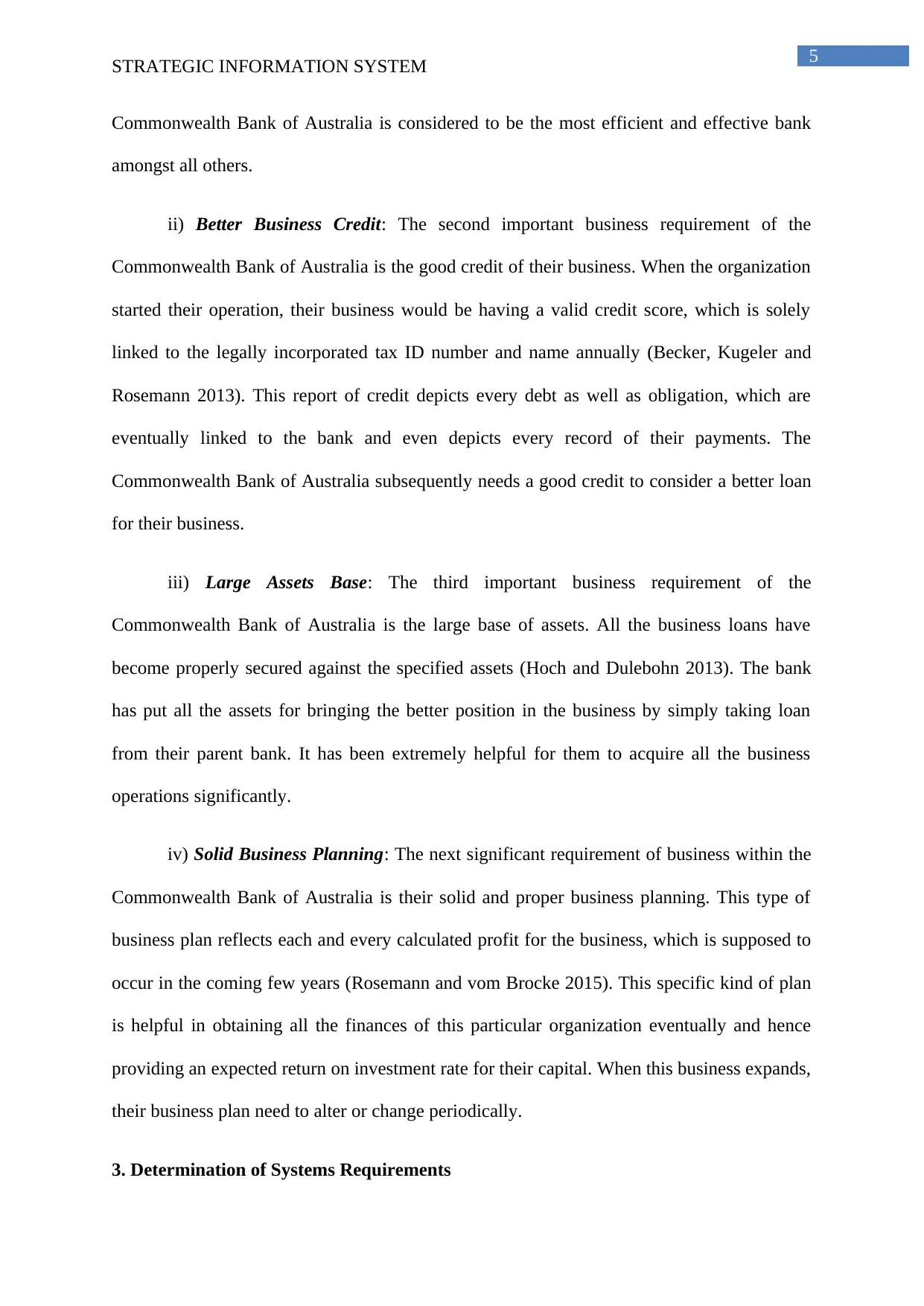
5
STRATEGIC INFORMATION SYSTEM
Commonwealth Bank of Australia is considered to be the most efficient and effective bank
amongst all others.
ii) Better Business Credit: The second important business requirement of the
Commonwealth Bank of Australia is the good credit of their business. When the organization
started their operation, their business would be having a valid credit score, which is solely
linked to the legally incorporated tax ID number and name annually (Becker, Kugeler and
Rosemann 2013). This report of credit depicts every debt as well as obligation, which are
eventually linked to the bank and even depicts every record of their payments. The
Commonwealth Bank of Australia subsequently needs a good credit to consider a better loan
for their business.
iii) Large Assets Base: The third important business requirement of the
Commonwealth Bank of Australia is the large base of assets. All the business loans have
become properly secured against the specified assets (Hoch and Dulebohn 2013). The bank
has put all the assets for bringing the better position in the business by simply taking loan
from their parent bank. It has been extremely helpful for them to acquire all the business
operations significantly.
iv) Solid Business Planning: The next significant requirement of business within the
Commonwealth Bank of Australia is their solid and proper business planning. This type of
business plan reflects each and every calculated profit for the business, which is supposed to
occur in the coming few years (Rosemann and vom Brocke 2015). This specific kind of plan
is helpful in obtaining all the finances of this particular organization eventually and hence
providing an expected return on investment rate for their capital. When this business expands,
their business plan need to alter or change periodically.
3. Determination of Systems Requirements
STRATEGIC INFORMATION SYSTEM
Commonwealth Bank of Australia is considered to be the most efficient and effective bank
amongst all others.
ii) Better Business Credit: The second important business requirement of the
Commonwealth Bank of Australia is the good credit of their business. When the organization
started their operation, their business would be having a valid credit score, which is solely
linked to the legally incorporated tax ID number and name annually (Becker, Kugeler and
Rosemann 2013). This report of credit depicts every debt as well as obligation, which are
eventually linked to the bank and even depicts every record of their payments. The
Commonwealth Bank of Australia subsequently needs a good credit to consider a better loan
for their business.
iii) Large Assets Base: The third important business requirement of the
Commonwealth Bank of Australia is the large base of assets. All the business loans have
become properly secured against the specified assets (Hoch and Dulebohn 2013). The bank
has put all the assets for bringing the better position in the business by simply taking loan
from their parent bank. It has been extremely helpful for them to acquire all the business
operations significantly.
iv) Solid Business Planning: The next significant requirement of business within the
Commonwealth Bank of Australia is their solid and proper business planning. This type of
business plan reflects each and every calculated profit for the business, which is supposed to
occur in the coming few years (Rosemann and vom Brocke 2015). This specific kind of plan
is helpful in obtaining all the finances of this particular organization eventually and hence
providing an expected return on investment rate for their capital. When this business expands,
their business plan need to alter or change periodically.
3. Determination of Systems Requirements
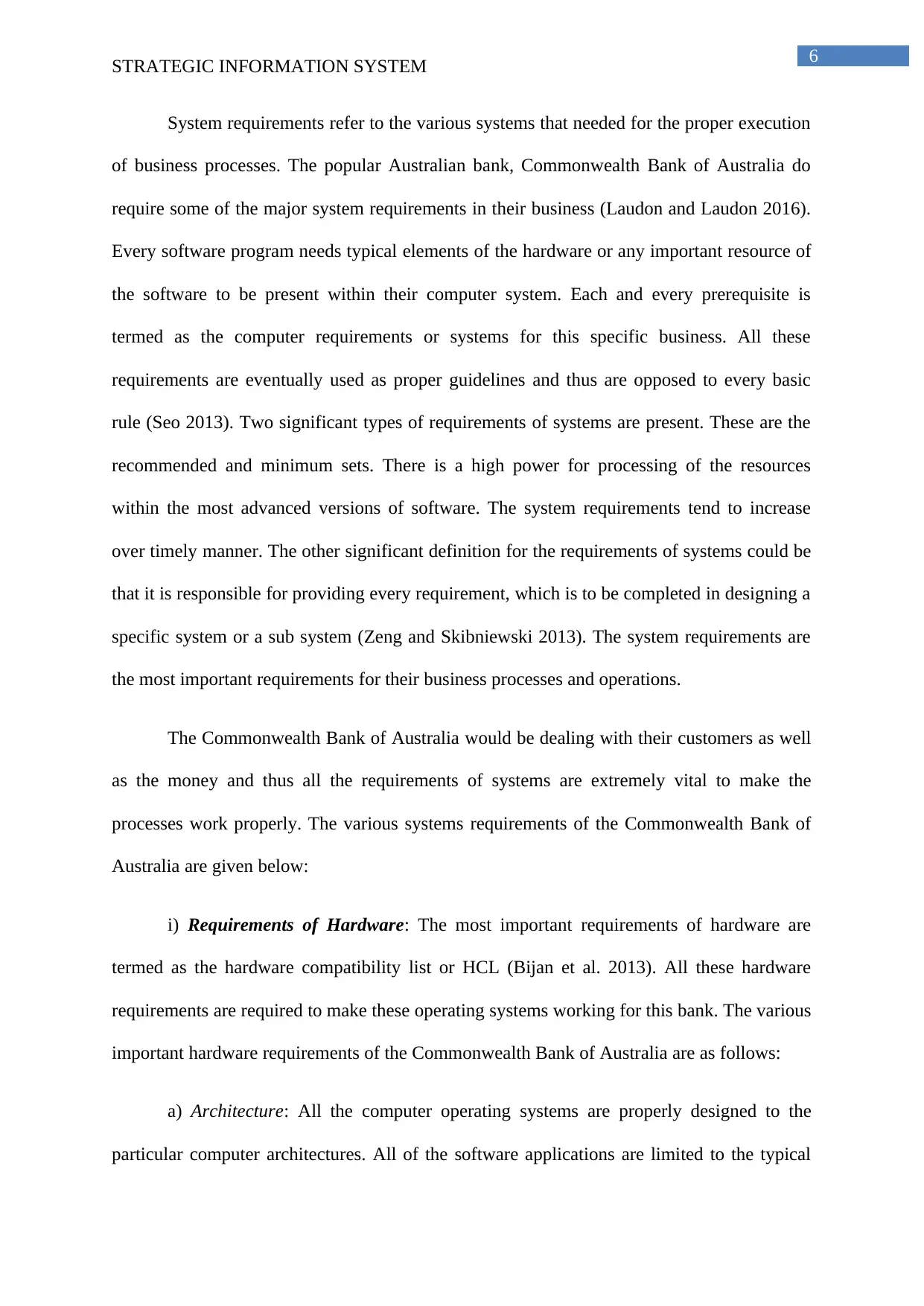
6
STRATEGIC INFORMATION SYSTEM
System requirements refer to the various systems that needed for the proper execution
of business processes. The popular Australian bank, Commonwealth Bank of Australia do
require some of the major system requirements in their business (Laudon and Laudon 2016).
Every software program needs typical elements of the hardware or any important resource of
the software to be present within their computer system. Each and every prerequisite is
termed as the computer requirements or systems for this specific business. All these
requirements are eventually used as proper guidelines and thus are opposed to every basic
rule (Seo 2013). Two significant types of requirements of systems are present. These are the
recommended and minimum sets. There is a high power for processing of the resources
within the most advanced versions of software. The system requirements tend to increase
over timely manner. The other significant definition for the requirements of systems could be
that it is responsible for providing every requirement, which is to be completed in designing a
specific system or a sub system (Zeng and Skibniewski 2013). The system requirements are
the most important requirements for their business processes and operations.
The Commonwealth Bank of Australia would be dealing with their customers as well
as the money and thus all the requirements of systems are extremely vital to make the
processes work properly. The various systems requirements of the Commonwealth Bank of
Australia are given below:
i) Requirements of Hardware: The most important requirements of hardware are
termed as the hardware compatibility list or HCL (Bijan et al. 2013). All these hardware
requirements are required to make these operating systems working for this bank. The various
important hardware requirements of the Commonwealth Bank of Australia are as follows:
a) Architecture: All the computer operating systems are properly designed to the
particular computer architectures. All of the software applications are limited to the typical
STRATEGIC INFORMATION SYSTEM
System requirements refer to the various systems that needed for the proper execution
of business processes. The popular Australian bank, Commonwealth Bank of Australia do
require some of the major system requirements in their business (Laudon and Laudon 2016).
Every software program needs typical elements of the hardware or any important resource of
the software to be present within their computer system. Each and every prerequisite is
termed as the computer requirements or systems for this specific business. All these
requirements are eventually used as proper guidelines and thus are opposed to every basic
rule (Seo 2013). Two significant types of requirements of systems are present. These are the
recommended and minimum sets. There is a high power for processing of the resources
within the most advanced versions of software. The system requirements tend to increase
over timely manner. The other significant definition for the requirements of systems could be
that it is responsible for providing every requirement, which is to be completed in designing a
specific system or a sub system (Zeng and Skibniewski 2013). The system requirements are
the most important requirements for their business processes and operations.
The Commonwealth Bank of Australia would be dealing with their customers as well
as the money and thus all the requirements of systems are extremely vital to make the
processes work properly. The various systems requirements of the Commonwealth Bank of
Australia are given below:
i) Requirements of Hardware: The most important requirements of hardware are
termed as the hardware compatibility list or HCL (Bijan et al. 2013). All these hardware
requirements are required to make these operating systems working for this bank. The various
important hardware requirements of the Commonwealth Bank of Australia are as follows:
a) Architecture: All the computer operating systems are properly designed to the
particular computer architectures. All of the software applications are limited to the typical
Paraphrase This Document
Need a fresh take? Get an instant paraphrase of this document with our AI Paraphraser
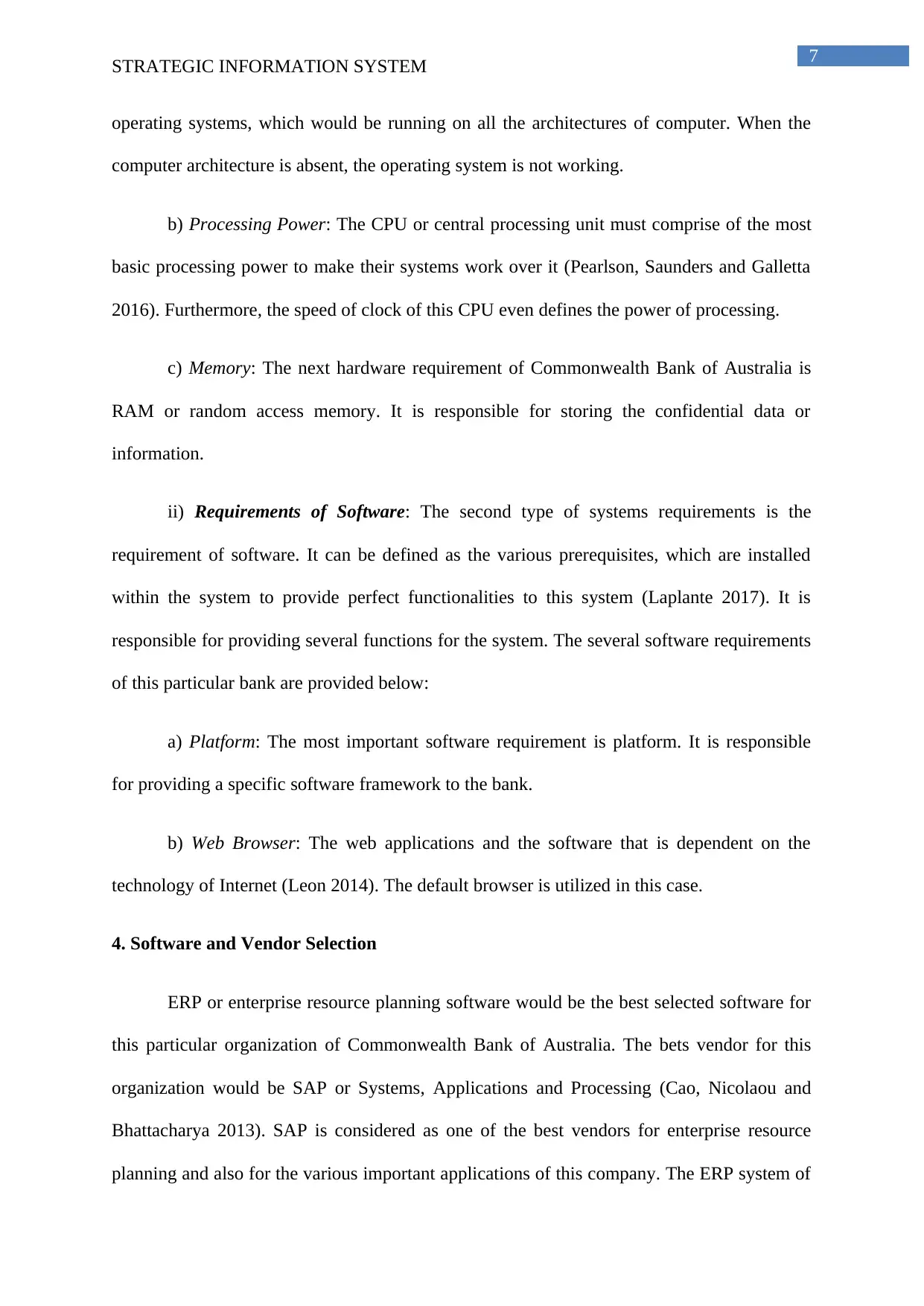
7
STRATEGIC INFORMATION SYSTEM
operating systems, which would be running on all the architectures of computer. When the
computer architecture is absent, the operating system is not working.
b) Processing Power: The CPU or central processing unit must comprise of the most
basic processing power to make their systems work over it (Pearlson, Saunders and Galletta
2016). Furthermore, the speed of clock of this CPU even defines the power of processing.
c) Memory: The next hardware requirement of Commonwealth Bank of Australia is
RAM or random access memory. It is responsible for storing the confidential data or
information.
ii) Requirements of Software: The second type of systems requirements is the
requirement of software. It can be defined as the various prerequisites, which are installed
within the system to provide perfect functionalities to this system (Laplante 2017). It is
responsible for providing several functions for the system. The several software requirements
of this particular bank are provided below:
a) Platform: The most important software requirement is platform. It is responsible
for providing a specific software framework to the bank.
b) Web Browser: The web applications and the software that is dependent on the
technology of Internet (Leon 2014). The default browser is utilized in this case.
4. Software and Vendor Selection
ERP or enterprise resource planning software would be the best selected software for
this particular organization of Commonwealth Bank of Australia. The bets vendor for this
organization would be SAP or Systems, Applications and Processing (Cao, Nicolaou and
Bhattacharya 2013). SAP is considered as one of the best vendors for enterprise resource
planning and also for the various important applications of this company. The ERP system of
STRATEGIC INFORMATION SYSTEM
operating systems, which would be running on all the architectures of computer. When the
computer architecture is absent, the operating system is not working.
b) Processing Power: The CPU or central processing unit must comprise of the most
basic processing power to make their systems work over it (Pearlson, Saunders and Galletta
2016). Furthermore, the speed of clock of this CPU even defines the power of processing.
c) Memory: The next hardware requirement of Commonwealth Bank of Australia is
RAM or random access memory. It is responsible for storing the confidential data or
information.
ii) Requirements of Software: The second type of systems requirements is the
requirement of software. It can be defined as the various prerequisites, which are installed
within the system to provide perfect functionalities to this system (Laplante 2017). It is
responsible for providing several functions for the system. The several software requirements
of this particular bank are provided below:
a) Platform: The most important software requirement is platform. It is responsible
for providing a specific software framework to the bank.
b) Web Browser: The web applications and the software that is dependent on the
technology of Internet (Leon 2014). The default browser is utilized in this case.
4. Software and Vendor Selection
ERP or enterprise resource planning software would be the best selected software for
this particular organization of Commonwealth Bank of Australia. The bets vendor for this
organization would be SAP or Systems, Applications and Processing (Cao, Nicolaou and
Bhattacharya 2013). SAP is considered as one of the best vendors for enterprise resource
planning and also for the various important applications of this company. The ERP system of
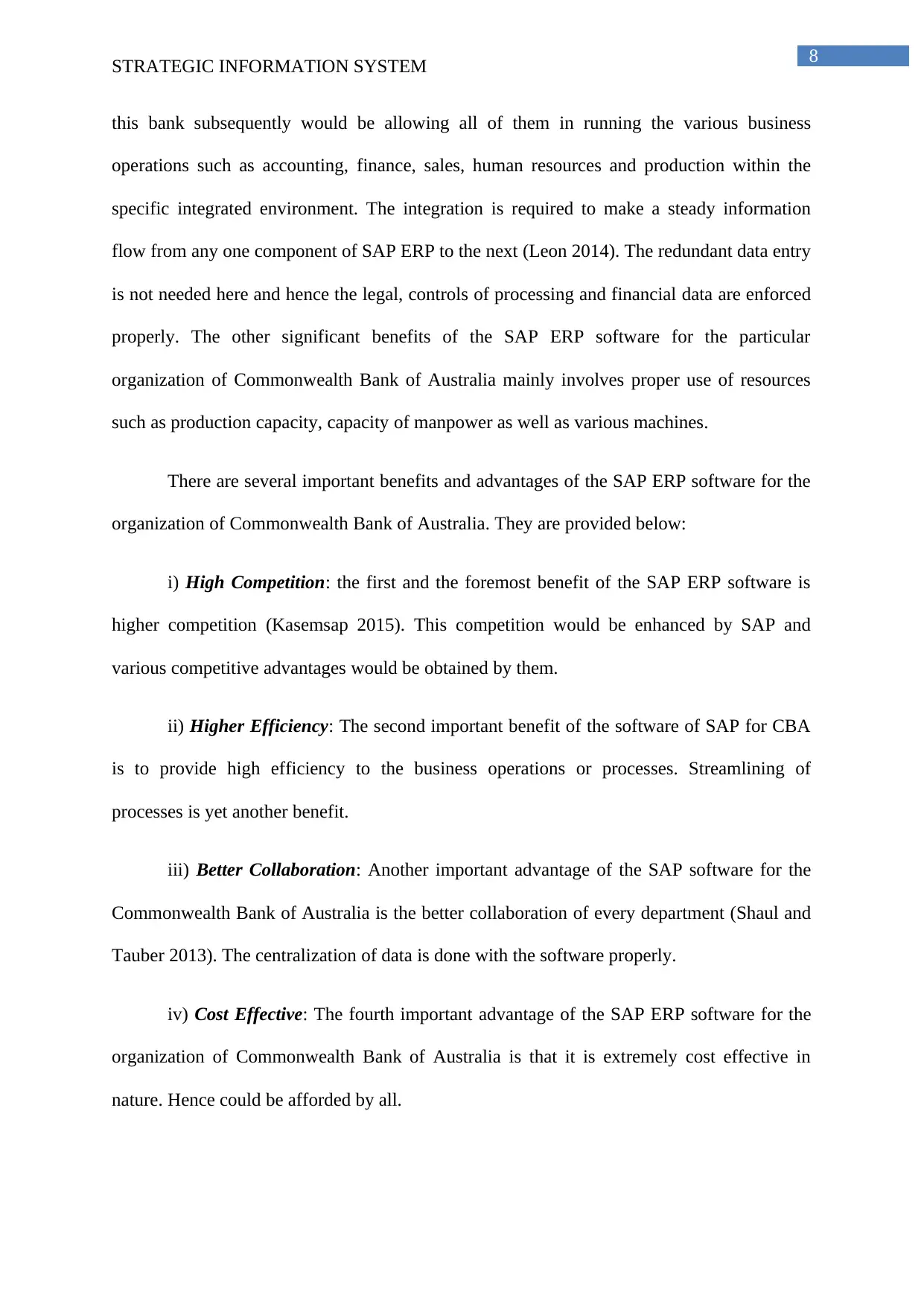
8
STRATEGIC INFORMATION SYSTEM
this bank subsequently would be allowing all of them in running the various business
operations such as accounting, finance, sales, human resources and production within the
specific integrated environment. The integration is required to make a steady information
flow from any one component of SAP ERP to the next (Leon 2014). The redundant data entry
is not needed here and hence the legal, controls of processing and financial data are enforced
properly. The other significant benefits of the SAP ERP software for the particular
organization of Commonwealth Bank of Australia mainly involves proper use of resources
such as production capacity, capacity of manpower as well as various machines.
There are several important benefits and advantages of the SAP ERP software for the
organization of Commonwealth Bank of Australia. They are provided below:
i) High Competition: the first and the foremost benefit of the SAP ERP software is
higher competition (Kasemsap 2015). This competition would be enhanced by SAP and
various competitive advantages would be obtained by them.
ii) Higher Efficiency: The second important benefit of the software of SAP for CBA
is to provide high efficiency to the business operations or processes. Streamlining of
processes is yet another benefit.
iii) Better Collaboration: Another important advantage of the SAP software for the
Commonwealth Bank of Australia is the better collaboration of every department (Shaul and
Tauber 2013). The centralization of data is done with the software properly.
iv) Cost Effective: The fourth important advantage of the SAP ERP software for the
organization of Commonwealth Bank of Australia is that it is extremely cost effective in
nature. Hence could be afforded by all.
STRATEGIC INFORMATION SYSTEM
this bank subsequently would be allowing all of them in running the various business
operations such as accounting, finance, sales, human resources and production within the
specific integrated environment. The integration is required to make a steady information
flow from any one component of SAP ERP to the next (Leon 2014). The redundant data entry
is not needed here and hence the legal, controls of processing and financial data are enforced
properly. The other significant benefits of the SAP ERP software for the particular
organization of Commonwealth Bank of Australia mainly involves proper use of resources
such as production capacity, capacity of manpower as well as various machines.
There are several important benefits and advantages of the SAP ERP software for the
organization of Commonwealth Bank of Australia. They are provided below:
i) High Competition: the first and the foremost benefit of the SAP ERP software is
higher competition (Kasemsap 2015). This competition would be enhanced by SAP and
various competitive advantages would be obtained by them.
ii) Higher Efficiency: The second important benefit of the software of SAP for CBA
is to provide high efficiency to the business operations or processes. Streamlining of
processes is yet another benefit.
iii) Better Collaboration: Another important advantage of the SAP software for the
Commonwealth Bank of Australia is the better collaboration of every department (Shaul and
Tauber 2013). The centralization of data is done with the software properly.
iv) Cost Effective: The fourth important advantage of the SAP ERP software for the
organization of Commonwealth Bank of Australia is that it is extremely cost effective in
nature. Hence could be afforded by all.
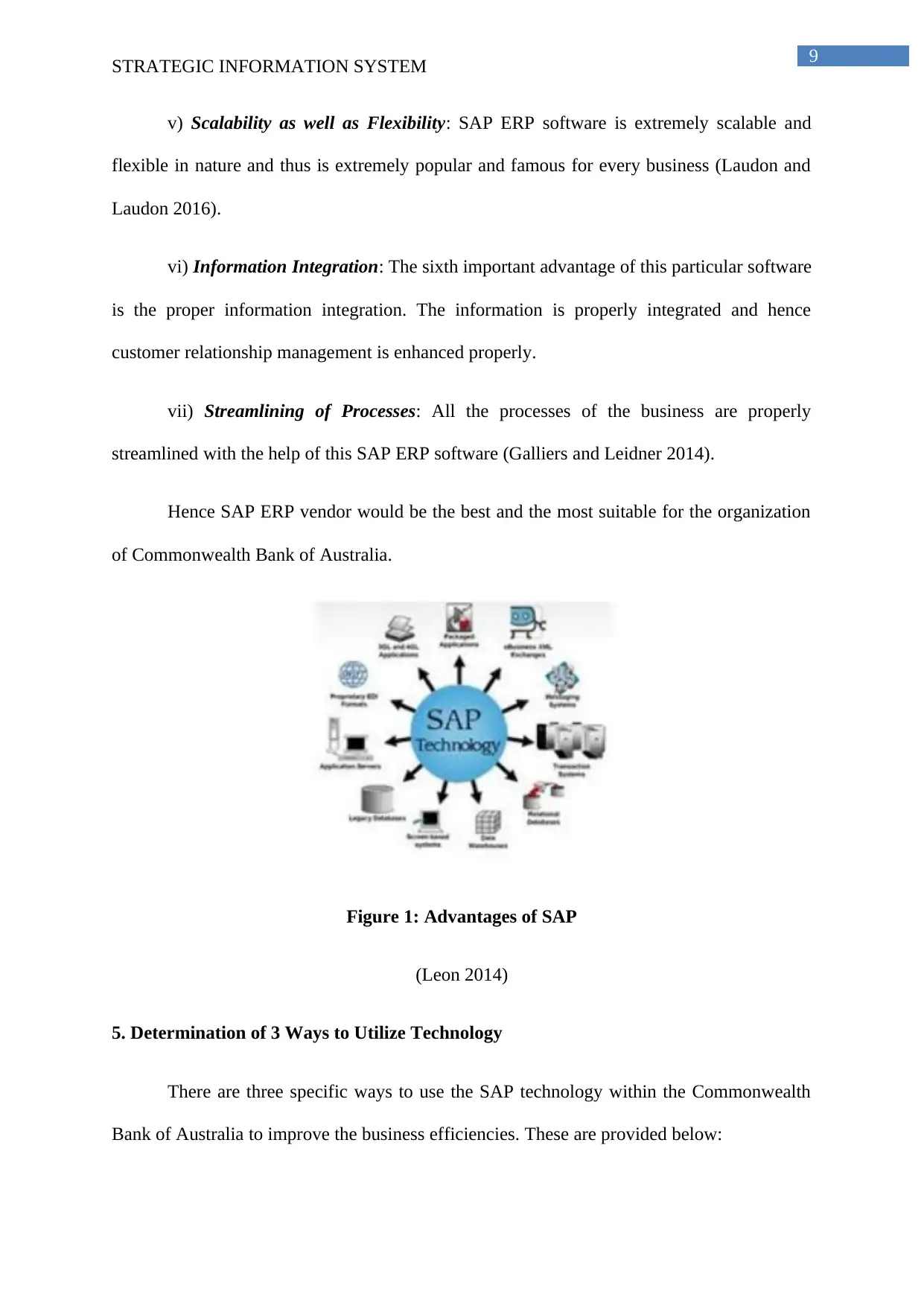
9
STRATEGIC INFORMATION SYSTEM
v) Scalability as well as Flexibility: SAP ERP software is extremely scalable and
flexible in nature and thus is extremely popular and famous for every business (Laudon and
Laudon 2016).
vi) Information Integration: The sixth important advantage of this particular software
is the proper information integration. The information is properly integrated and hence
customer relationship management is enhanced properly.
vii) Streamlining of Processes: All the processes of the business are properly
streamlined with the help of this SAP ERP software (Galliers and Leidner 2014).
Hence SAP ERP vendor would be the best and the most suitable for the organization
of Commonwealth Bank of Australia.
Figure 1: Advantages of SAP
(Leon 2014)
5. Determination of 3 Ways to Utilize Technology
There are three specific ways to use the SAP technology within the Commonwealth
Bank of Australia to improve the business efficiencies. These are provided below:
STRATEGIC INFORMATION SYSTEM
v) Scalability as well as Flexibility: SAP ERP software is extremely scalable and
flexible in nature and thus is extremely popular and famous for every business (Laudon and
Laudon 2016).
vi) Information Integration: The sixth important advantage of this particular software
is the proper information integration. The information is properly integrated and hence
customer relationship management is enhanced properly.
vii) Streamlining of Processes: All the processes of the business are properly
streamlined with the help of this SAP ERP software (Galliers and Leidner 2014).
Hence SAP ERP vendor would be the best and the most suitable for the organization
of Commonwealth Bank of Australia.
Figure 1: Advantages of SAP
(Leon 2014)
5. Determination of 3 Ways to Utilize Technology
There are three specific ways to use the SAP technology within the Commonwealth
Bank of Australia to improve the business efficiencies. These are provided below:
Secure Best Marks with AI Grader
Need help grading? Try our AI Grader for instant feedback on your assignments.
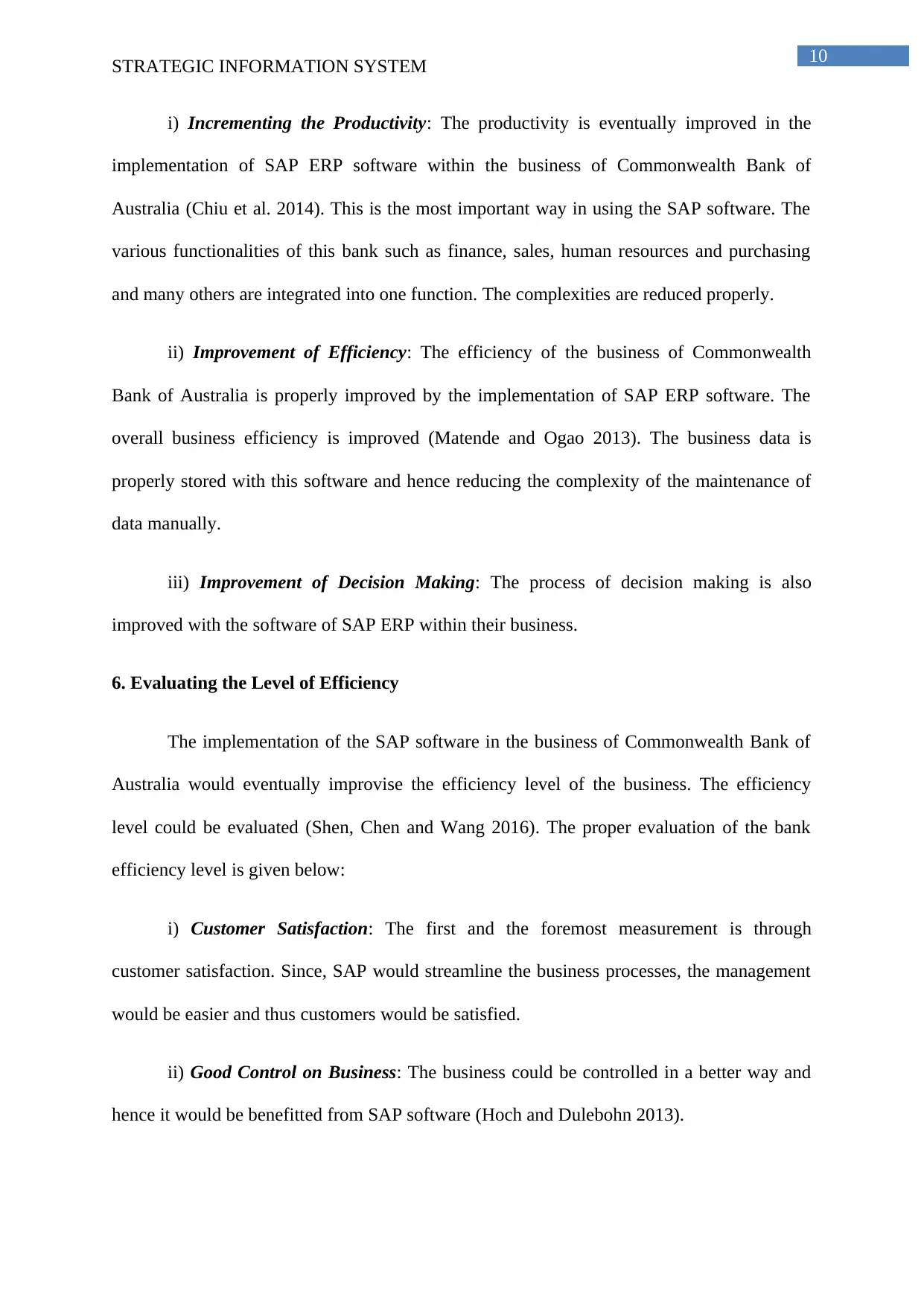
10
STRATEGIC INFORMATION SYSTEM
i) Incrementing the Productivity: The productivity is eventually improved in the
implementation of SAP ERP software within the business of Commonwealth Bank of
Australia (Chiu et al. 2014). This is the most important way in using the SAP software. The
various functionalities of this bank such as finance, sales, human resources and purchasing
and many others are integrated into one function. The complexities are reduced properly.
ii) Improvement of Efficiency: The efficiency of the business of Commonwealth
Bank of Australia is properly improved by the implementation of SAP ERP software. The
overall business efficiency is improved (Matende and Ogao 2013). The business data is
properly stored with this software and hence reducing the complexity of the maintenance of
data manually.
iii) Improvement of Decision Making: The process of decision making is also
improved with the software of SAP ERP within their business.
6. Evaluating the Level of Efficiency
The implementation of the SAP software in the business of Commonwealth Bank of
Australia would eventually improvise the efficiency level of the business. The efficiency
level could be evaluated (Shen, Chen and Wang 2016). The proper evaluation of the bank
efficiency level is given below:
i) Customer Satisfaction: The first and the foremost measurement is through
customer satisfaction. Since, SAP would streamline the business processes, the management
would be easier and thus customers would be satisfied.
ii) Good Control on Business: The business could be controlled in a better way and
hence it would be benefitted from SAP software (Hoch and Dulebohn 2013).
STRATEGIC INFORMATION SYSTEM
i) Incrementing the Productivity: The productivity is eventually improved in the
implementation of SAP ERP software within the business of Commonwealth Bank of
Australia (Chiu et al. 2014). This is the most important way in using the SAP software. The
various functionalities of this bank such as finance, sales, human resources and purchasing
and many others are integrated into one function. The complexities are reduced properly.
ii) Improvement of Efficiency: The efficiency of the business of Commonwealth
Bank of Australia is properly improved by the implementation of SAP ERP software. The
overall business efficiency is improved (Matende and Ogao 2013). The business data is
properly stored with this software and hence reducing the complexity of the maintenance of
data manually.
iii) Improvement of Decision Making: The process of decision making is also
improved with the software of SAP ERP within their business.
6. Evaluating the Level of Efficiency
The implementation of the SAP software in the business of Commonwealth Bank of
Australia would eventually improvise the efficiency level of the business. The efficiency
level could be evaluated (Shen, Chen and Wang 2016). The proper evaluation of the bank
efficiency level is given below:
i) Customer Satisfaction: The first and the foremost measurement is through
customer satisfaction. Since, SAP would streamline the business processes, the management
would be easier and thus customers would be satisfied.
ii) Good Control on Business: The business could be controlled in a better way and
hence it would be benefitted from SAP software (Hoch and Dulebohn 2013).
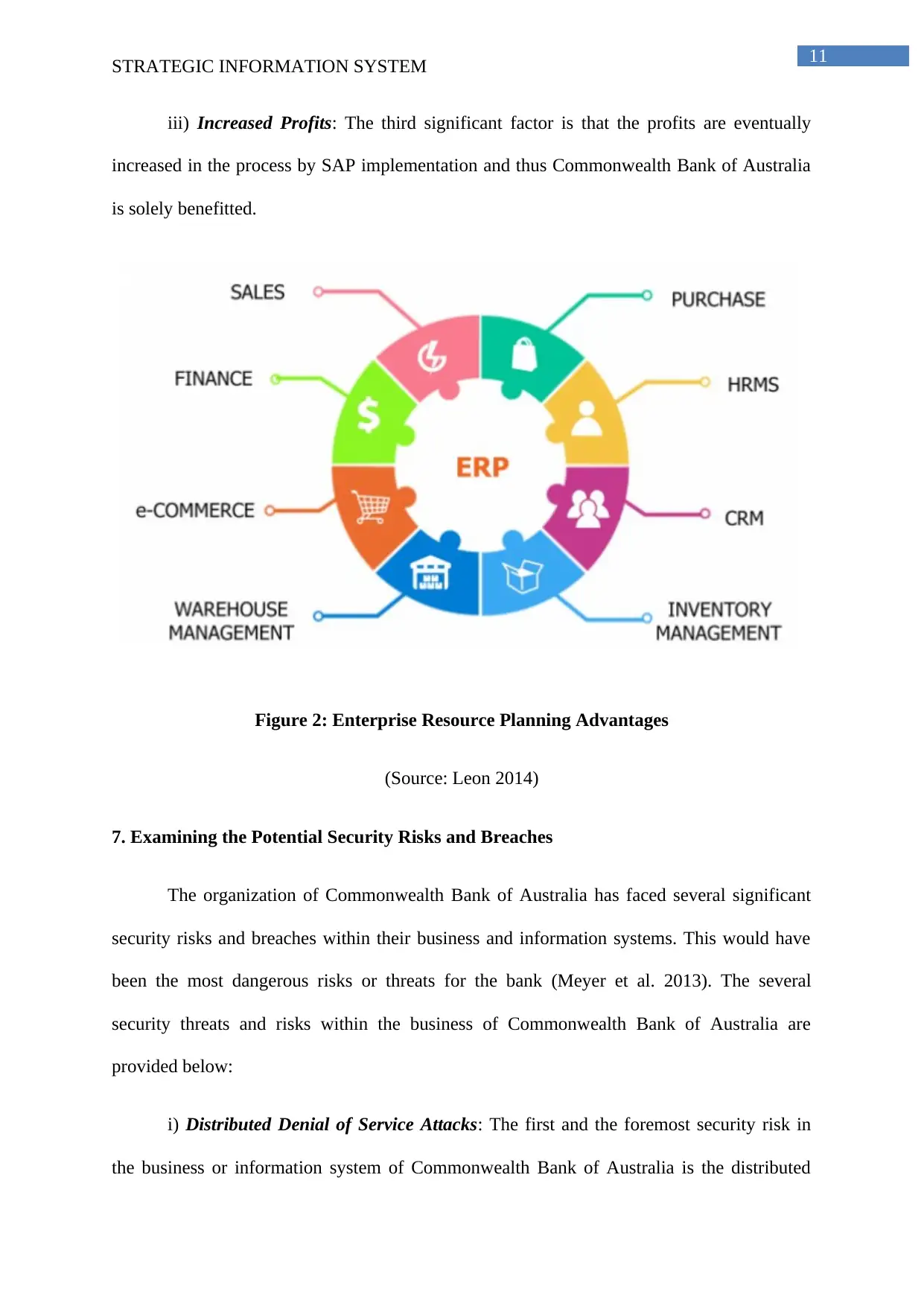
11
STRATEGIC INFORMATION SYSTEM
iii) Increased Profits: The third significant factor is that the profits are eventually
increased in the process by SAP implementation and thus Commonwealth Bank of Australia
is solely benefitted.
Figure 2: Enterprise Resource Planning Advantages
(Source: Leon 2014)
7. Examining the Potential Security Risks and Breaches
The organization of Commonwealth Bank of Australia has faced several significant
security risks and breaches within their business and information systems. This would have
been the most dangerous risks or threats for the bank (Meyer et al. 2013). The several
security threats and risks within the business of Commonwealth Bank of Australia are
provided below:
i) Distributed Denial of Service Attacks: The first and the foremost security risk in
the business or information system of Commonwealth Bank of Australia is the distributed
STRATEGIC INFORMATION SYSTEM
iii) Increased Profits: The third significant factor is that the profits are eventually
increased in the process by SAP implementation and thus Commonwealth Bank of Australia
is solely benefitted.
Figure 2: Enterprise Resource Planning Advantages
(Source: Leon 2014)
7. Examining the Potential Security Risks and Breaches
The organization of Commonwealth Bank of Australia has faced several significant
security risks and breaches within their business and information systems. This would have
been the most dangerous risks or threats for the bank (Meyer et al. 2013). The several
security threats and risks within the business of Commonwealth Bank of Australia are
provided below:
i) Distributed Denial of Service Attacks: The first and the foremost security risk in
the business or information system of Commonwealth Bank of Australia is the distributed
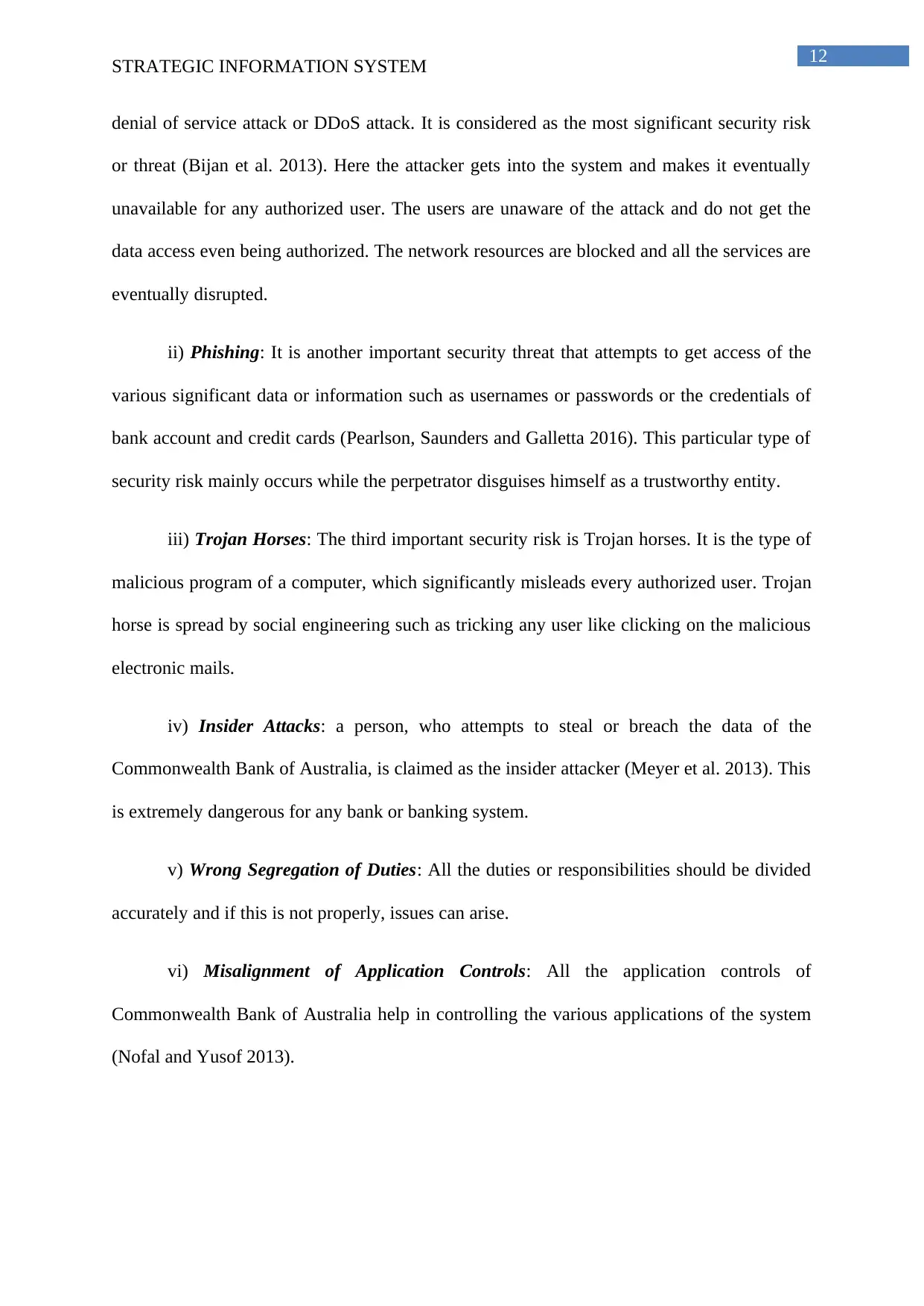
12
STRATEGIC INFORMATION SYSTEM
denial of service attack or DDoS attack. It is considered as the most significant security risk
or threat (Bijan et al. 2013). Here the attacker gets into the system and makes it eventually
unavailable for any authorized user. The users are unaware of the attack and do not get the
data access even being authorized. The network resources are blocked and all the services are
eventually disrupted.
ii) Phishing: It is another important security threat that attempts to get access of the
various significant data or information such as usernames or passwords or the credentials of
bank account and credit cards (Pearlson, Saunders and Galletta 2016). This particular type of
security risk mainly occurs while the perpetrator disguises himself as a trustworthy entity.
iii) Trojan Horses: The third important security risk is Trojan horses. It is the type of
malicious program of a computer, which significantly misleads every authorized user. Trojan
horse is spread by social engineering such as tricking any user like clicking on the malicious
electronic mails.
iv) Insider Attacks: a person, who attempts to steal or breach the data of the
Commonwealth Bank of Australia, is claimed as the insider attacker (Meyer et al. 2013). This
is extremely dangerous for any bank or banking system.
v) Wrong Segregation of Duties: All the duties or responsibilities should be divided
accurately and if this is not properly, issues can arise.
vi) Misalignment of Application Controls: All the application controls of
Commonwealth Bank of Australia help in controlling the various applications of the system
(Nofal and Yusof 2013).
STRATEGIC INFORMATION SYSTEM
denial of service attack or DDoS attack. It is considered as the most significant security risk
or threat (Bijan et al. 2013). Here the attacker gets into the system and makes it eventually
unavailable for any authorized user. The users are unaware of the attack and do not get the
data access even being authorized. The network resources are blocked and all the services are
eventually disrupted.
ii) Phishing: It is another important security threat that attempts to get access of the
various significant data or information such as usernames or passwords or the credentials of
bank account and credit cards (Pearlson, Saunders and Galletta 2016). This particular type of
security risk mainly occurs while the perpetrator disguises himself as a trustworthy entity.
iii) Trojan Horses: The third important security risk is Trojan horses. It is the type of
malicious program of a computer, which significantly misleads every authorized user. Trojan
horse is spread by social engineering such as tricking any user like clicking on the malicious
electronic mails.
iv) Insider Attacks: a person, who attempts to steal or breach the data of the
Commonwealth Bank of Australia, is claimed as the insider attacker (Meyer et al. 2013). This
is extremely dangerous for any bank or banking system.
v) Wrong Segregation of Duties: All the duties or responsibilities should be divided
accurately and if this is not properly, issues can arise.
vi) Misalignment of Application Controls: All the application controls of
Commonwealth Bank of Australia help in controlling the various applications of the system
(Nofal and Yusof 2013).
Paraphrase This Document
Need a fresh take? Get an instant paraphrase of this document with our AI Paraphraser
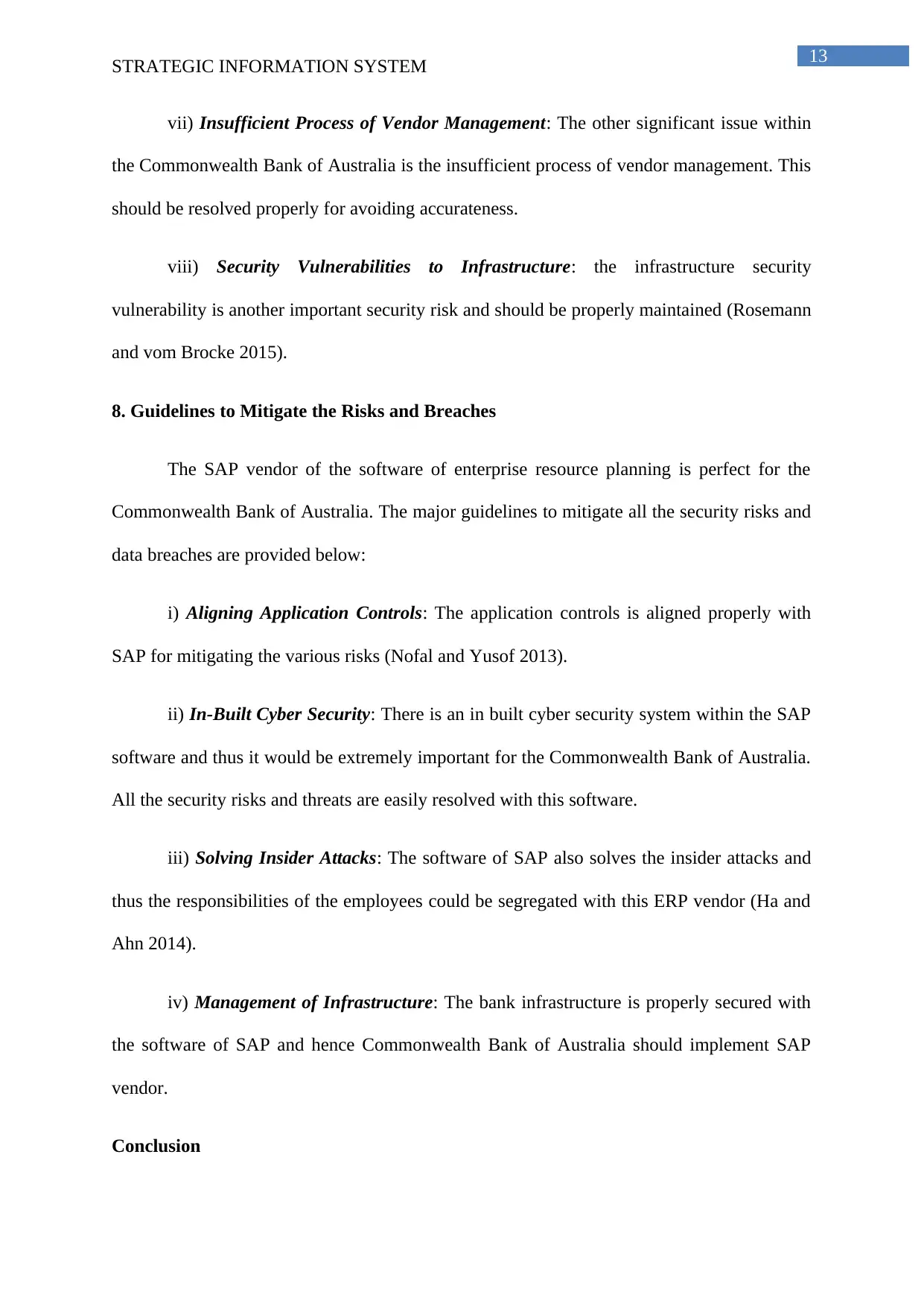
13
STRATEGIC INFORMATION SYSTEM
vii) Insufficient Process of Vendor Management: The other significant issue within
the Commonwealth Bank of Australia is the insufficient process of vendor management. This
should be resolved properly for avoiding accurateness.
viii) Security Vulnerabilities to Infrastructure: the infrastructure security
vulnerability is another important security risk and should be properly maintained (Rosemann
and vom Brocke 2015).
8. Guidelines to Mitigate the Risks and Breaches
The SAP vendor of the software of enterprise resource planning is perfect for the
Commonwealth Bank of Australia. The major guidelines to mitigate all the security risks and
data breaches are provided below:
i) Aligning Application Controls: The application controls is aligned properly with
SAP for mitigating the various risks (Nofal and Yusof 2013).
ii) In-Built Cyber Security: There is an in built cyber security system within the SAP
software and thus it would be extremely important for the Commonwealth Bank of Australia.
All the security risks and threats are easily resolved with this software.
iii) Solving Insider Attacks: The software of SAP also solves the insider attacks and
thus the responsibilities of the employees could be segregated with this ERP vendor (Ha and
Ahn 2014).
iv) Management of Infrastructure: The bank infrastructure is properly secured with
the software of SAP and hence Commonwealth Bank of Australia should implement SAP
vendor.
Conclusion
STRATEGIC INFORMATION SYSTEM
vii) Insufficient Process of Vendor Management: The other significant issue within
the Commonwealth Bank of Australia is the insufficient process of vendor management. This
should be resolved properly for avoiding accurateness.
viii) Security Vulnerabilities to Infrastructure: the infrastructure security
vulnerability is another important security risk and should be properly maintained (Rosemann
and vom Brocke 2015).
8. Guidelines to Mitigate the Risks and Breaches
The SAP vendor of the software of enterprise resource planning is perfect for the
Commonwealth Bank of Australia. The major guidelines to mitigate all the security risks and
data breaches are provided below:
i) Aligning Application Controls: The application controls is aligned properly with
SAP for mitigating the various risks (Nofal and Yusof 2013).
ii) In-Built Cyber Security: There is an in built cyber security system within the SAP
software and thus it would be extremely important for the Commonwealth Bank of Australia.
All the security risks and threats are easily resolved with this software.
iii) Solving Insider Attacks: The software of SAP also solves the insider attacks and
thus the responsibilities of the employees could be segregated with this ERP vendor (Ha and
Ahn 2014).
iv) Management of Infrastructure: The bank infrastructure is properly secured with
the software of SAP and hence Commonwealth Bank of Australia should implement SAP
vendor.
Conclusion
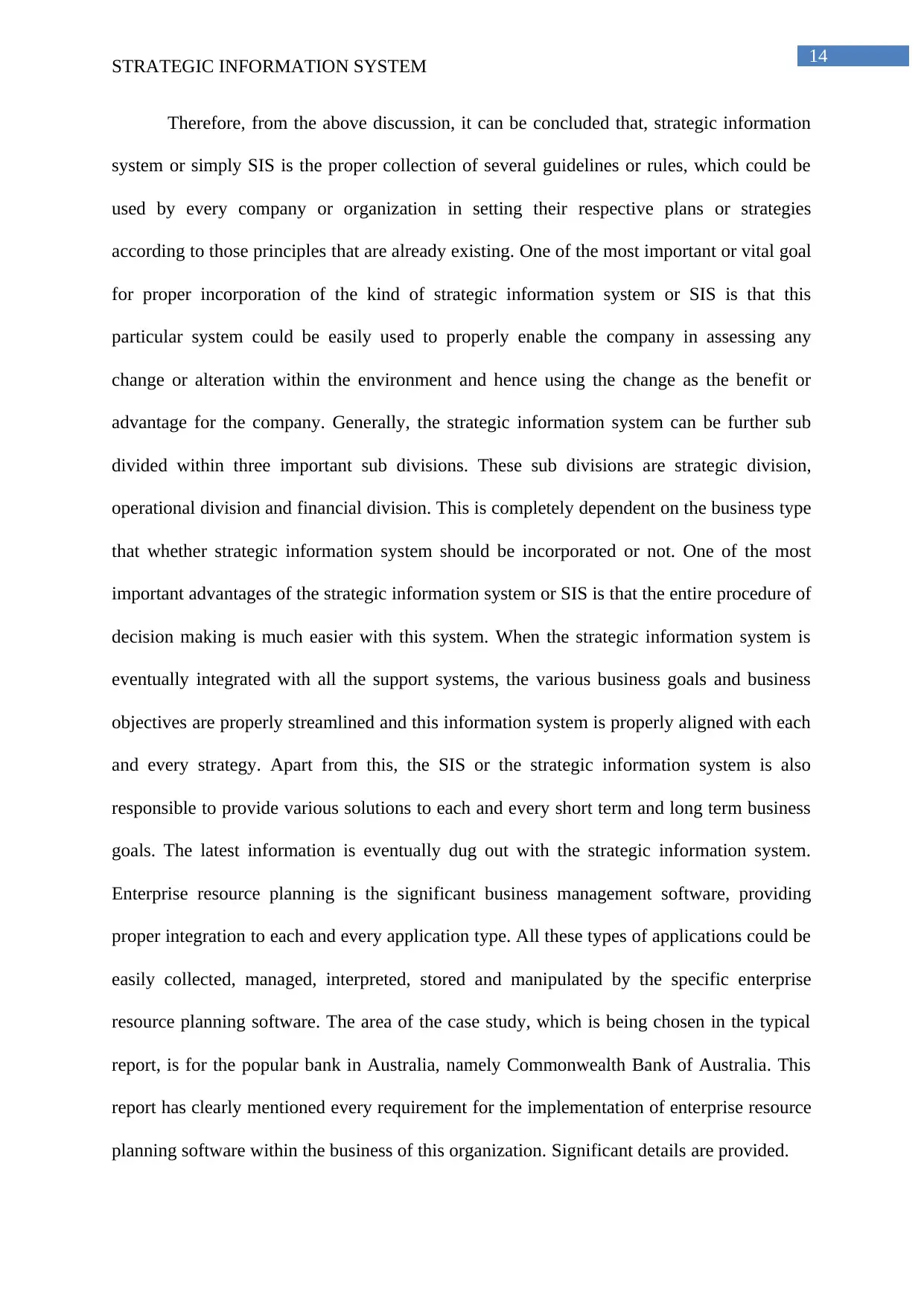
14
STRATEGIC INFORMATION SYSTEM
Therefore, from the above discussion, it can be concluded that, strategic information
system or simply SIS is the proper collection of several guidelines or rules, which could be
used by every company or organization in setting their respective plans or strategies
according to those principles that are already existing. One of the most important or vital goal
for proper incorporation of the kind of strategic information system or SIS is that this
particular system could be easily used to properly enable the company in assessing any
change or alteration within the environment and hence using the change as the benefit or
advantage for the company. Generally, the strategic information system can be further sub
divided within three important sub divisions. These sub divisions are strategic division,
operational division and financial division. This is completely dependent on the business type
that whether strategic information system should be incorporated or not. One of the most
important advantages of the strategic information system or SIS is that the entire procedure of
decision making is much easier with this system. When the strategic information system is
eventually integrated with all the support systems, the various business goals and business
objectives are properly streamlined and this information system is properly aligned with each
and every strategy. Apart from this, the SIS or the strategic information system is also
responsible to provide various solutions to each and every short term and long term business
goals. The latest information is eventually dug out with the strategic information system.
Enterprise resource planning is the significant business management software, providing
proper integration to each and every application type. All these types of applications could be
easily collected, managed, interpreted, stored and manipulated by the specific enterprise
resource planning software. The area of the case study, which is being chosen in the typical
report, is for the popular bank in Australia, namely Commonwealth Bank of Australia. This
report has clearly mentioned every requirement for the implementation of enterprise resource
planning software within the business of this organization. Significant details are provided.
STRATEGIC INFORMATION SYSTEM
Therefore, from the above discussion, it can be concluded that, strategic information
system or simply SIS is the proper collection of several guidelines or rules, which could be
used by every company or organization in setting their respective plans or strategies
according to those principles that are already existing. One of the most important or vital goal
for proper incorporation of the kind of strategic information system or SIS is that this
particular system could be easily used to properly enable the company in assessing any
change or alteration within the environment and hence using the change as the benefit or
advantage for the company. Generally, the strategic information system can be further sub
divided within three important sub divisions. These sub divisions are strategic division,
operational division and financial division. This is completely dependent on the business type
that whether strategic information system should be incorporated or not. One of the most
important advantages of the strategic information system or SIS is that the entire procedure of
decision making is much easier with this system. When the strategic information system is
eventually integrated with all the support systems, the various business goals and business
objectives are properly streamlined and this information system is properly aligned with each
and every strategy. Apart from this, the SIS or the strategic information system is also
responsible to provide various solutions to each and every short term and long term business
goals. The latest information is eventually dug out with the strategic information system.
Enterprise resource planning is the significant business management software, providing
proper integration to each and every application type. All these types of applications could be
easily collected, managed, interpreted, stored and manipulated by the specific enterprise
resource planning software. The area of the case study, which is being chosen in the typical
report, is for the popular bank in Australia, namely Commonwealth Bank of Australia. This
report has clearly mentioned every requirement for the implementation of enterprise resource
planning software within the business of this organization. Significant details are provided.
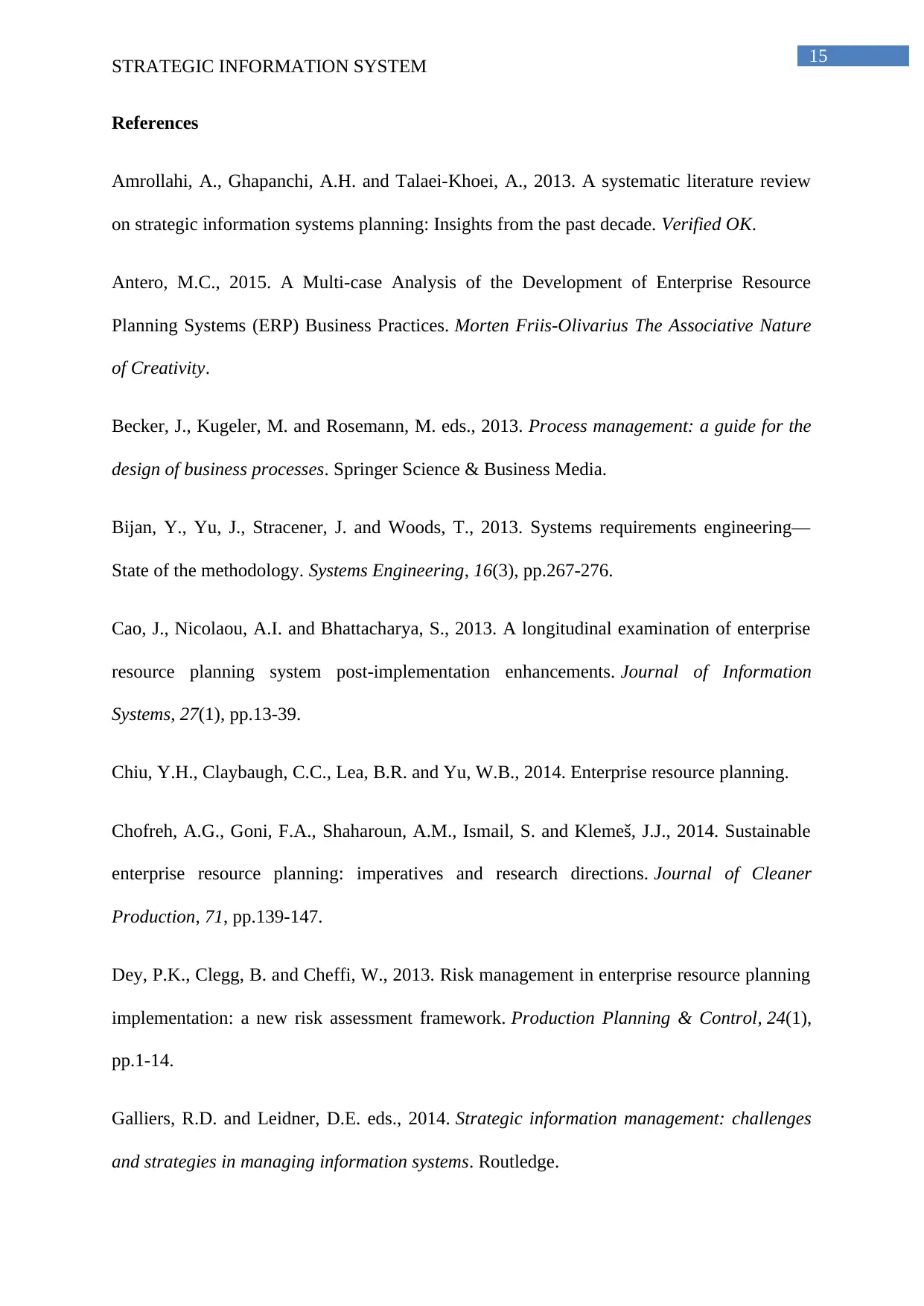
15
STRATEGIC INFORMATION SYSTEM
References
Amrollahi, A., Ghapanchi, A.H. and Talaei-Khoei, A., 2013. A systematic literature review
on strategic information systems planning: Insights from the past decade. Verified OK.
Antero, M.C., 2015. A Multi-case Analysis of the Development of Enterprise Resource
Planning Systems (ERP) Business Practices. Morten Friis-Olivarius The Associative Nature
of Creativity.
Becker, J., Kugeler, M. and Rosemann, M. eds., 2013. Process management: a guide for the
design of business processes. Springer Science & Business Media.
Bijan, Y., Yu, J., Stracener, J. and Woods, T., 2013. Systems requirements engineering—
State of the methodology. Systems Engineering, 16(3), pp.267-276.
Cao, J., Nicolaou, A.I. and Bhattacharya, S., 2013. A longitudinal examination of enterprise
resource planning system post-implementation enhancements. Journal of Information
Systems, 27(1), pp.13-39.
Chiu, Y.H., Claybaugh, C.C., Lea, B.R. and Yu, W.B., 2014. Enterprise resource planning.
Chofreh, A.G., Goni, F.A., Shaharoun, A.M., Ismail, S. and Klemeš, J.J., 2014. Sustainable
enterprise resource planning: imperatives and research directions. Journal of Cleaner
Production, 71, pp.139-147.
Dey, P.K., Clegg, B. and Cheffi, W., 2013. Risk management in enterprise resource planning
implementation: a new risk assessment framework. Production Planning & Control, 24(1),
pp.1-14.
Galliers, R.D. and Leidner, D.E. eds., 2014. Strategic information management: challenges
and strategies in managing information systems. Routledge.
STRATEGIC INFORMATION SYSTEM
References
Amrollahi, A., Ghapanchi, A.H. and Talaei-Khoei, A., 2013. A systematic literature review
on strategic information systems planning: Insights from the past decade. Verified OK.
Antero, M.C., 2015. A Multi-case Analysis of the Development of Enterprise Resource
Planning Systems (ERP) Business Practices. Morten Friis-Olivarius The Associative Nature
of Creativity.
Becker, J., Kugeler, M. and Rosemann, M. eds., 2013. Process management: a guide for the
design of business processes. Springer Science & Business Media.
Bijan, Y., Yu, J., Stracener, J. and Woods, T., 2013. Systems requirements engineering—
State of the methodology. Systems Engineering, 16(3), pp.267-276.
Cao, J., Nicolaou, A.I. and Bhattacharya, S., 2013. A longitudinal examination of enterprise
resource planning system post-implementation enhancements. Journal of Information
Systems, 27(1), pp.13-39.
Chiu, Y.H., Claybaugh, C.C., Lea, B.R. and Yu, W.B., 2014. Enterprise resource planning.
Chofreh, A.G., Goni, F.A., Shaharoun, A.M., Ismail, S. and Klemeš, J.J., 2014. Sustainable
enterprise resource planning: imperatives and research directions. Journal of Cleaner
Production, 71, pp.139-147.
Dey, P.K., Clegg, B. and Cheffi, W., 2013. Risk management in enterprise resource planning
implementation: a new risk assessment framework. Production Planning & Control, 24(1),
pp.1-14.
Galliers, R.D. and Leidner, D.E. eds., 2014. Strategic information management: challenges
and strategies in managing information systems. Routledge.
Secure Best Marks with AI Grader
Need help grading? Try our AI Grader for instant feedback on your assignments.
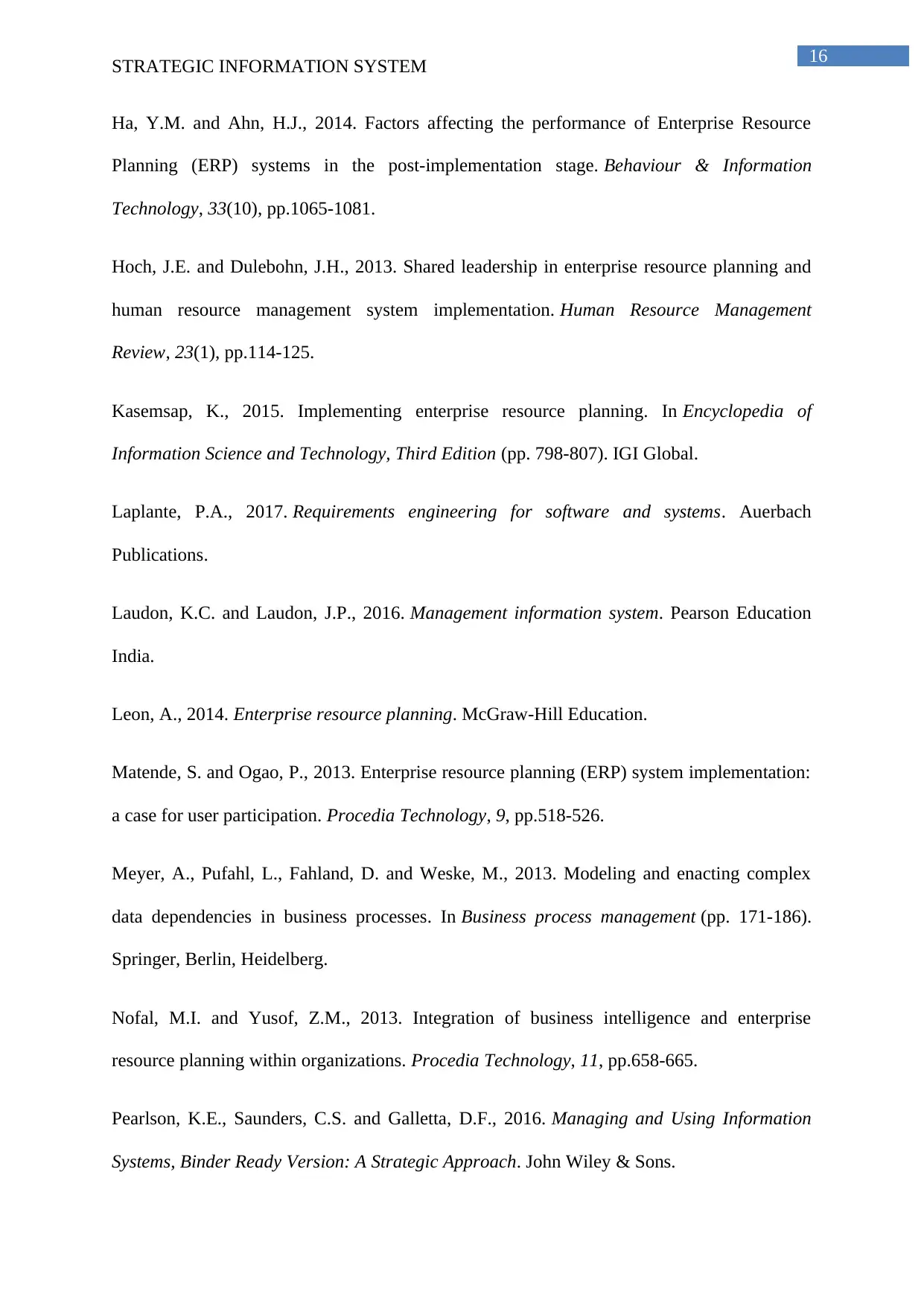
16
STRATEGIC INFORMATION SYSTEM
Ha, Y.M. and Ahn, H.J., 2014. Factors affecting the performance of Enterprise Resource
Planning (ERP) systems in the post-implementation stage. Behaviour & Information
Technology, 33(10), pp.1065-1081.
Hoch, J.E. and Dulebohn, J.H., 2013. Shared leadership in enterprise resource planning and
human resource management system implementation. Human Resource Management
Review, 23(1), pp.114-125.
Kasemsap, K., 2015. Implementing enterprise resource planning. In Encyclopedia of
Information Science and Technology, Third Edition (pp. 798-807). IGI Global.
Laplante, P.A., 2017. Requirements engineering for software and systems. Auerbach
Publications.
Laudon, K.C. and Laudon, J.P., 2016. Management information system. Pearson Education
India.
Leon, A., 2014. Enterprise resource planning. McGraw-Hill Education.
Matende, S. and Ogao, P., 2013. Enterprise resource planning (ERP) system implementation:
a case for user participation. Procedia Technology, 9, pp.518-526.
Meyer, A., Pufahl, L., Fahland, D. and Weske, M., 2013. Modeling and enacting complex
data dependencies in business processes. In Business process management (pp. 171-186).
Springer, Berlin, Heidelberg.
Nofal, M.I. and Yusof, Z.M., 2013. Integration of business intelligence and enterprise
resource planning within organizations. Procedia Technology, 11, pp.658-665.
Pearlson, K.E., Saunders, C.S. and Galletta, D.F., 2016. Managing and Using Information
Systems, Binder Ready Version: A Strategic Approach. John Wiley & Sons.
STRATEGIC INFORMATION SYSTEM
Ha, Y.M. and Ahn, H.J., 2014. Factors affecting the performance of Enterprise Resource
Planning (ERP) systems in the post-implementation stage. Behaviour & Information
Technology, 33(10), pp.1065-1081.
Hoch, J.E. and Dulebohn, J.H., 2013. Shared leadership in enterprise resource planning and
human resource management system implementation. Human Resource Management
Review, 23(1), pp.114-125.
Kasemsap, K., 2015. Implementing enterprise resource planning. In Encyclopedia of
Information Science and Technology, Third Edition (pp. 798-807). IGI Global.
Laplante, P.A., 2017. Requirements engineering for software and systems. Auerbach
Publications.
Laudon, K.C. and Laudon, J.P., 2016. Management information system. Pearson Education
India.
Leon, A., 2014. Enterprise resource planning. McGraw-Hill Education.
Matende, S. and Ogao, P., 2013. Enterprise resource planning (ERP) system implementation:
a case for user participation. Procedia Technology, 9, pp.518-526.
Meyer, A., Pufahl, L., Fahland, D. and Weske, M., 2013. Modeling and enacting complex
data dependencies in business processes. In Business process management (pp. 171-186).
Springer, Berlin, Heidelberg.
Nofal, M.I. and Yusof, Z.M., 2013. Integration of business intelligence and enterprise
resource planning within organizations. Procedia Technology, 11, pp.658-665.
Pearlson, K.E., Saunders, C.S. and Galletta, D.F., 2016. Managing and Using Information
Systems, Binder Ready Version: A Strategic Approach. John Wiley & Sons.
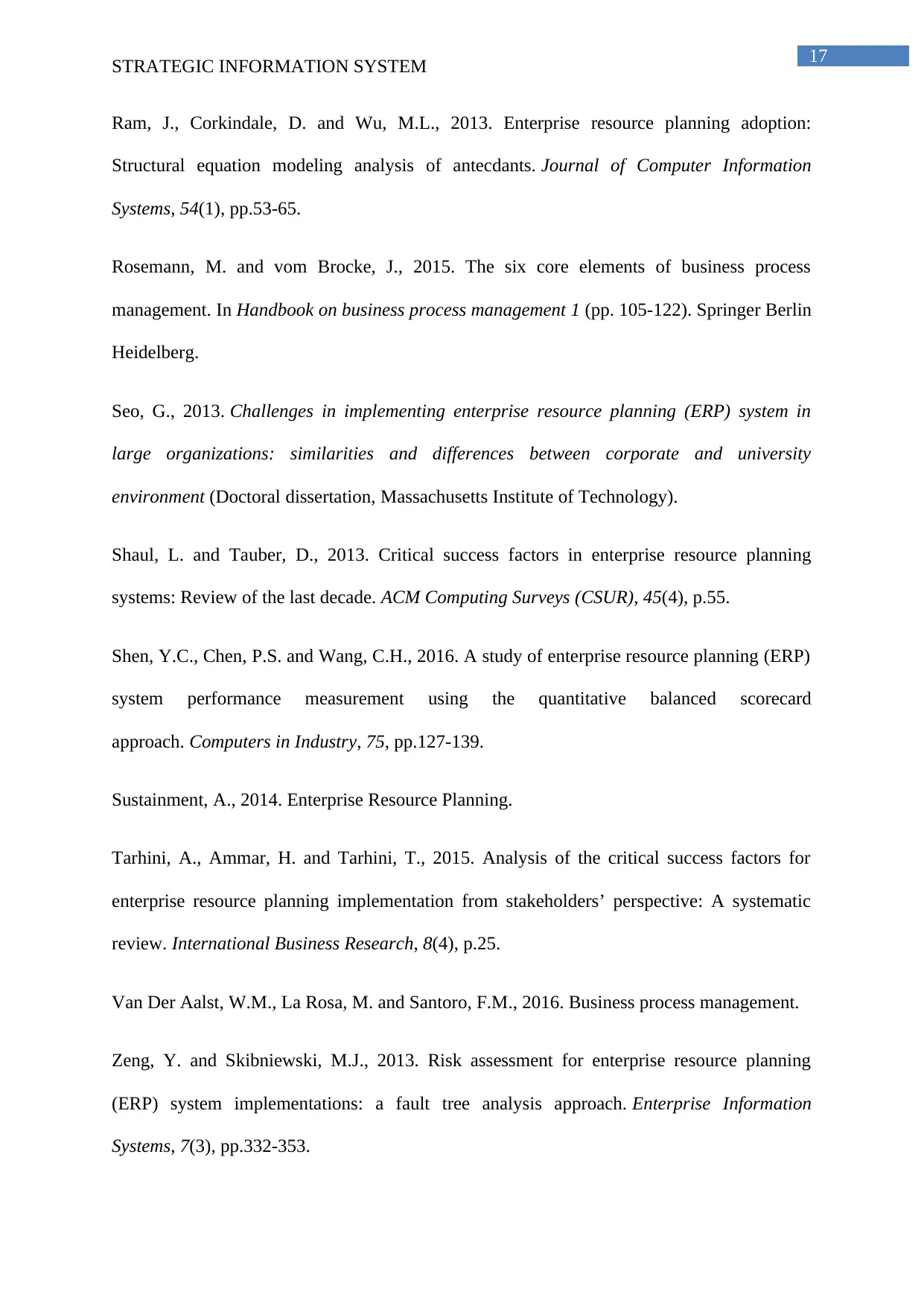
17
STRATEGIC INFORMATION SYSTEM
Ram, J., Corkindale, D. and Wu, M.L., 2013. Enterprise resource planning adoption:
Structural equation modeling analysis of antecdants. Journal of Computer Information
Systems, 54(1), pp.53-65.
Rosemann, M. and vom Brocke, J., 2015. The six core elements of business process
management. In Handbook on business process management 1 (pp. 105-122). Springer Berlin
Heidelberg.
Seo, G., 2013. Challenges in implementing enterprise resource planning (ERP) system in
large organizations: similarities and differences between corporate and university
environment (Doctoral dissertation, Massachusetts Institute of Technology).
Shaul, L. and Tauber, D., 2013. Critical success factors in enterprise resource planning
systems: Review of the last decade. ACM Computing Surveys (CSUR), 45(4), p.55.
Shen, Y.C., Chen, P.S. and Wang, C.H., 2016. A study of enterprise resource planning (ERP)
system performance measurement using the quantitative balanced scorecard
approach. Computers in Industry, 75, pp.127-139.
Sustainment, A., 2014. Enterprise Resource Planning.
Tarhini, A., Ammar, H. and Tarhini, T., 2015. Analysis of the critical success factors for
enterprise resource planning implementation from stakeholders’ perspective: A systematic
review. International Business Research, 8(4), p.25.
Van Der Aalst, W.M., La Rosa, M. and Santoro, F.M., 2016. Business process management.
Zeng, Y. and Skibniewski, M.J., 2013. Risk assessment for enterprise resource planning
(ERP) system implementations: a fault tree analysis approach. Enterprise Information
Systems, 7(3), pp.332-353.
STRATEGIC INFORMATION SYSTEM
Ram, J., Corkindale, D. and Wu, M.L., 2013. Enterprise resource planning adoption:
Structural equation modeling analysis of antecdants. Journal of Computer Information
Systems, 54(1), pp.53-65.
Rosemann, M. and vom Brocke, J., 2015. The six core elements of business process
management. In Handbook on business process management 1 (pp. 105-122). Springer Berlin
Heidelberg.
Seo, G., 2013. Challenges in implementing enterprise resource planning (ERP) system in
large organizations: similarities and differences between corporate and university
environment (Doctoral dissertation, Massachusetts Institute of Technology).
Shaul, L. and Tauber, D., 2013. Critical success factors in enterprise resource planning
systems: Review of the last decade. ACM Computing Surveys (CSUR), 45(4), p.55.
Shen, Y.C., Chen, P.S. and Wang, C.H., 2016. A study of enterprise resource planning (ERP)
system performance measurement using the quantitative balanced scorecard
approach. Computers in Industry, 75, pp.127-139.
Sustainment, A., 2014. Enterprise Resource Planning.
Tarhini, A., Ammar, H. and Tarhini, T., 2015. Analysis of the critical success factors for
enterprise resource planning implementation from stakeholders’ perspective: A systematic
review. International Business Research, 8(4), p.25.
Van Der Aalst, W.M., La Rosa, M. and Santoro, F.M., 2016. Business process management.
Zeng, Y. and Skibniewski, M.J., 2013. Risk assessment for enterprise resource planning
(ERP) system implementations: a fault tree analysis approach. Enterprise Information
Systems, 7(3), pp.332-353.
1 out of 18
Related Documents
Your All-in-One AI-Powered Toolkit for Academic Success.
+13062052269
info@desklib.com
Available 24*7 on WhatsApp / Email
![[object Object]](/_next/static/media/star-bottom.7253800d.svg)
Unlock your academic potential
© 2024 | Zucol Services PVT LTD | All rights reserved.





